I first visited Kyiv Ukraine in 1992, the first year of Perestroika, and again in 1993. I met Ukrainian artists in New York City by chance during an open art studio day in Brooklyn, and one of the artists I met was from Kyiv. She spontaneously invited me to visit her hometown, saying she would set me up with a place to stay (this was pre-AirBnb), and connect me with all of her artist friends.
I instantly made plans to go to Kyiv.
What I discovered was a strong community of creative practitioners who all seemed to know one another. Their network was wide, and extended into all the major cities of the former Soviet Union, as they had all attended school together. Their art practice was both conceptual and tactile, encompassing the plastic arts, i.e. painting, drawing, batik, metal, ceramics and sculpture. Though they were resource-poor, they were conceptually rich, and the fact that I was an artist from America intrigued them.
Now, 27 years later I am returning to Kyiv to work with Ukrainian artists, but this time around themes of artificial intelligence and art. It’s quite a leap in creative techniques since my previous visit. What is new is that Ukraine is rich in a new type of natural resource – computer programmers. According to a study by Deep Knowledge Analytics, taken from a database compiled by Clutch.co, Ukraine has the most outsourcing companies in artificial intelligence in both Eastern and Western Europe. The authors of the Deep Knowledge Analytic report also cite LinkedIn as listing more than 2,000 companies who develop AI related platforms.
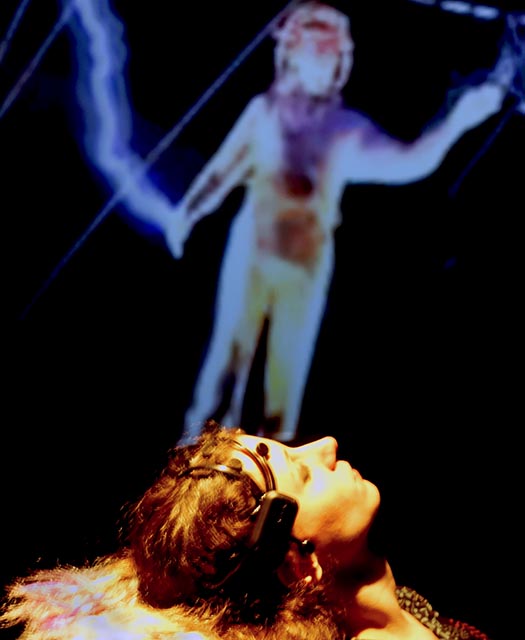
This dovetails with my current arts practice, as I work with biometric indicators (brain computer interfaces) as well as AI. I created “Noor,” a fully immersive interactive brainwave opera, as well as “AIBO” an emotionally intelligent AI brainwave opera. I am also a Director of an high-end art and technology residency in New York called ThoughtWorks Arts that works with cutting-edge technologies such as cyborgs, illegal harvesting of genetic data, breath and virtual reality, facial recognition and AI, movement and robotics, volumetric filmmaking, blockchain and AI, as well as synthetic media. In addition, I run Art-A-Hack ™ a creative group collaboration that brings artists and technologists together to "make something new." The groups contain experts as well as non-experts, and it is this methodology or toolkit I will use when working with Ukrainian artists.
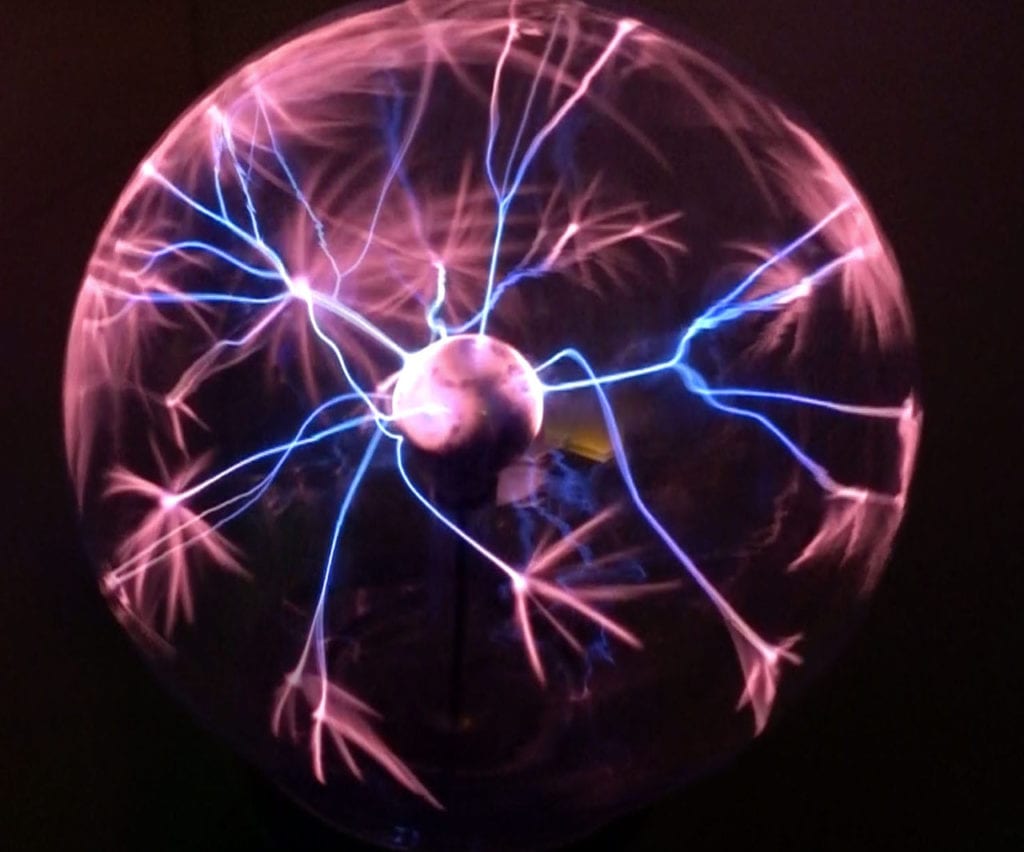
My host organization IZOLYATSIA is finding participants such as creative technologists, as well as artists both from Kyiv and outlying Ukrainian cities at their new location in Kyiv. IZOLYATSIA “orientates its activity toward the new Ukrainian generation that is involved in the creative and cultural sectors. We will work together to create projects on “Digital Literacy and New Horizons in AI and Art.” I am very interested to see the unique Ukrainian perspectives on technology and art.
Ellen Pearlman's incubator will take place from April 2-25, 2020 at IZOLYATSIA with support from U.S. Embassy Kyiv.
National Museum of Kosovo. Photograph by Bujar Imer Gashi - Own work, CC BY-SA 3.0, https://commons.wikimedia.org/w/index.php?curid=30814712
In a few weeks, I will be arriving in Pristina, Kosovo on the somewhat magical-feeling, transient leap year day, February 29th. That most of my travel from Pittsburgh, PA falls on this day will amuse me as I prepare for my month of leading workshops in youth empowerment to a group of Kosovar artists, makers, and dreamers.
When I was given my American Arts Incubator assignment, all that I knew about Kosovo was that there had been a war in 1999 while I was in my last months of high school. I asked around to my contacts to see if anyone had ever spent time there. Two people said that they had. One scolded me for my post about hoping to find moments of lightness and joy with the communities, even 20 years after the war. The other, a photojournalist who had also been there during the war, remembered her translators fondly as generous women who she kept in touch with as they married and had children. Her recollections of generosity and friendship from the people of Kosovo are what I am looking forward most to experiencing soon.
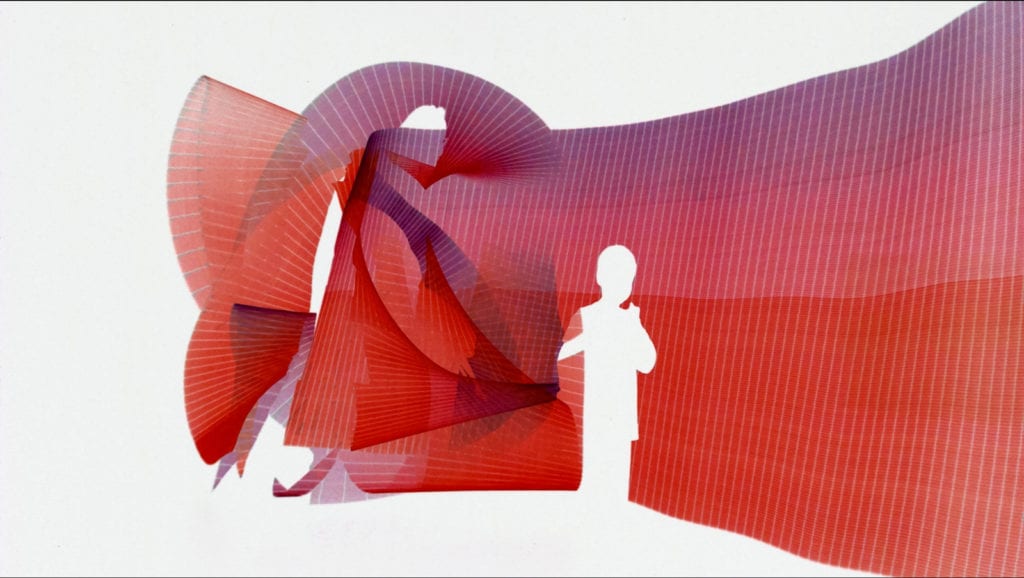
When I said moments of lightness earlier, I used the term intentionally, as much of my own art practice has used LEDs to show my bodily gestures with images and text in real time performances with projections; in other words lightpainting. The workshop that I will be conducting in Pristina, Tracing Pathways: Youth Movement, Light, and Wearable Technology, will lead participants in creating wearables with custom sewn LEDs that will be used in creating real-time projection pieces that can also trigger augmented reality animations and videos. After learning some of these techniques from my practice and discussing what youth empowerment means for them, the participants will be breaking into four groups to develop community-centered projects that will continue after my own departure.
I started working with LEDs in an early investigation of digital identity that merged lights, movement, and code in the days when Twitter couldn’t embed images. The investigation has grown and morphed beyond my initial expectations as a photographer and into my current practice. It now contains real-time projection, putting me in front of the camera, as well as setting up performances for others as a part of community-engaged, public art workshops.
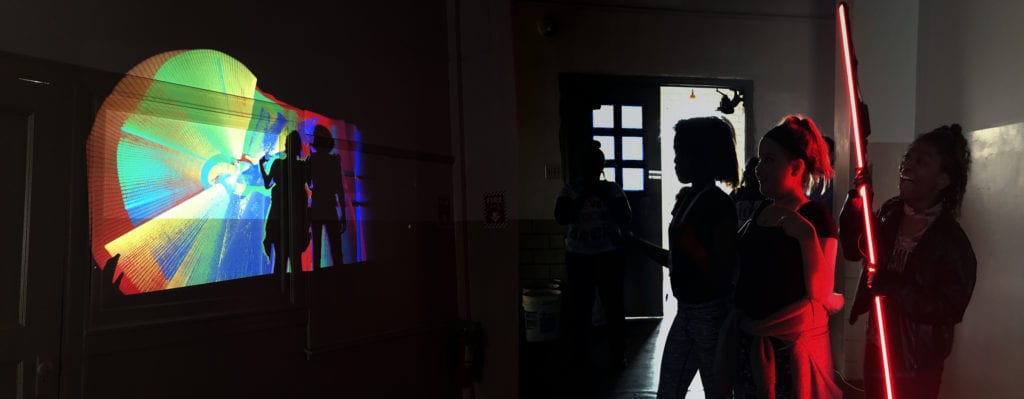
My practice now uses wearable LEDs, real-time projection, 6’ tall light sticks that look like something out of Star Wars, as well as contains community participants in public art workshops who wouldn’t necessarily consider themselves artists. The expansion of my individual, studio-based practice started when I started calling myself an artist, rather than just a photographer, even though I had always used performative means within my photography.
I am now designing systems and workshops to facilitate the joy that I feel when expressing my emotions through movement and light by allowing others to have this same magical experience that the technology facilitates. Community-centered public art has become an outlet where facilitation becomes collaborations with communities where we are all essential to the creation process, which often leads to unexpectedly joyful outcomes. I’m looking forward to my time in Kosovo and to see where some lights can take us.
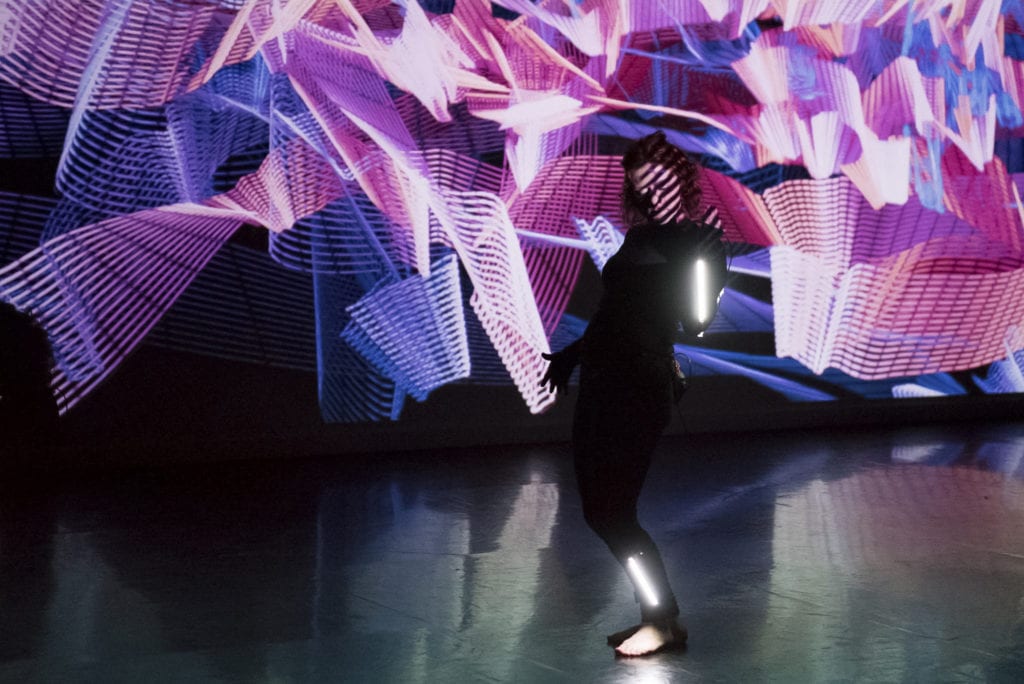
Lori Hepner's incubator will take place from March 6-29, 2020 at the National Museum of Kosovo with support from U.S. Embassy Pristina.
At the end of May, I completed my ZERO1 American Arts Incubator exchange in Pachuca, hosted by CITNOVA. I arrived in Mexico City a few days prior to the beginning of my exchange, where I spent five days exploring museums, historical and cultural sites, and learning as much as I could about Mexico’s largest city before departing to Pachuca which is situated approximately 2 hours north in the state of Hidalgo.

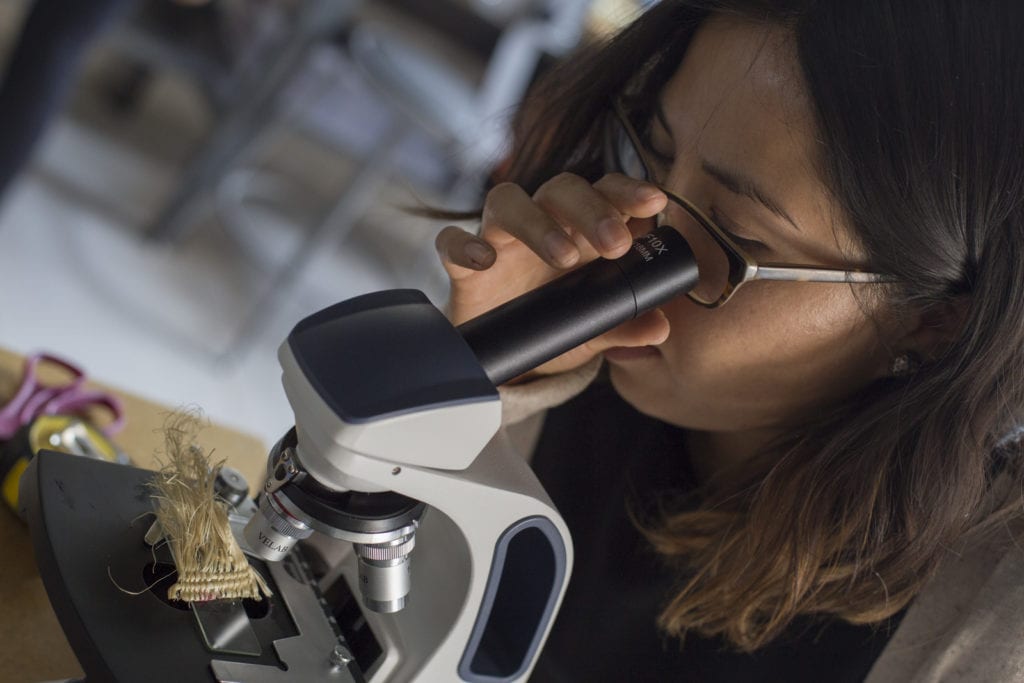
After the opening ceremony, the participants and I hit the ground running with four workshops. The workshops explored technical skills such as 3D printing, 3D scanning, laser cutting, and wearable electronics. All technical skills were framed within the context of considering how these technologies and processes could be used to create works and experiences that were rooted in narratives surrounding cultural identity. Through spending in-depth time together at the beginning of the program, I learned about the personal histories of each participant and the rich diversity of the group.
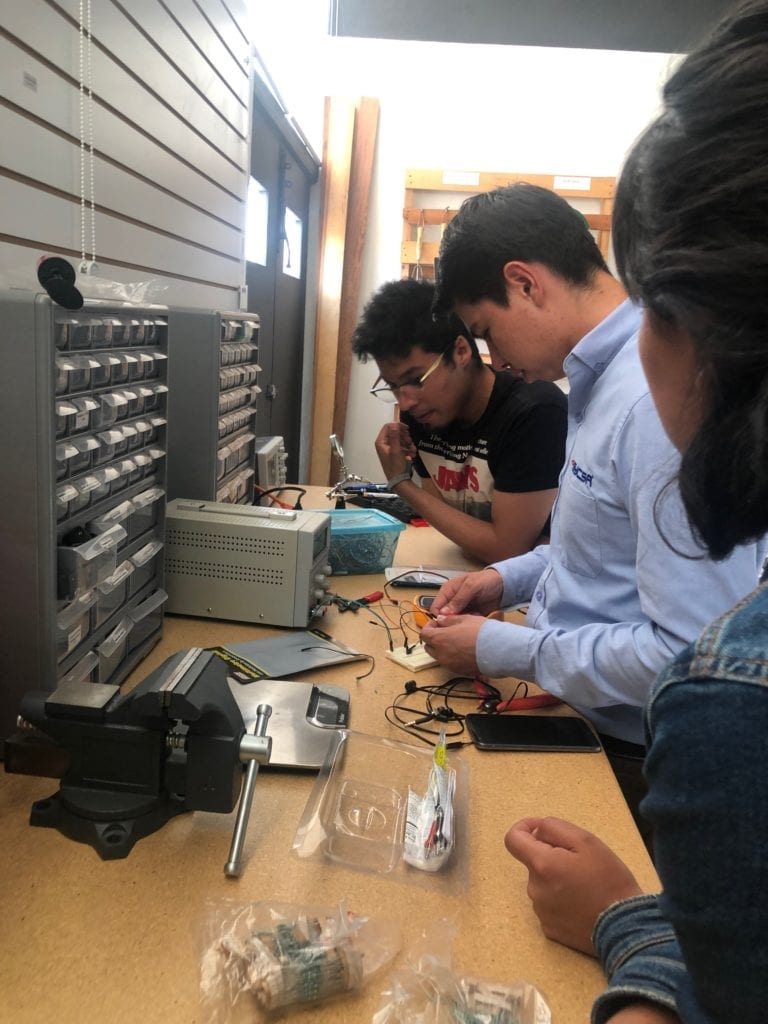

Upon arrival in Pachuca, I was greeted by CITNOVA with a fantastic opening ceremony for our program. In attendance were representatives from the U.S. Department of State Education and Cultural Affairs, as well as local government officials and other community members. It was a great way to start our experience and the first day for me to meet the participants and learn more about Pachuca.
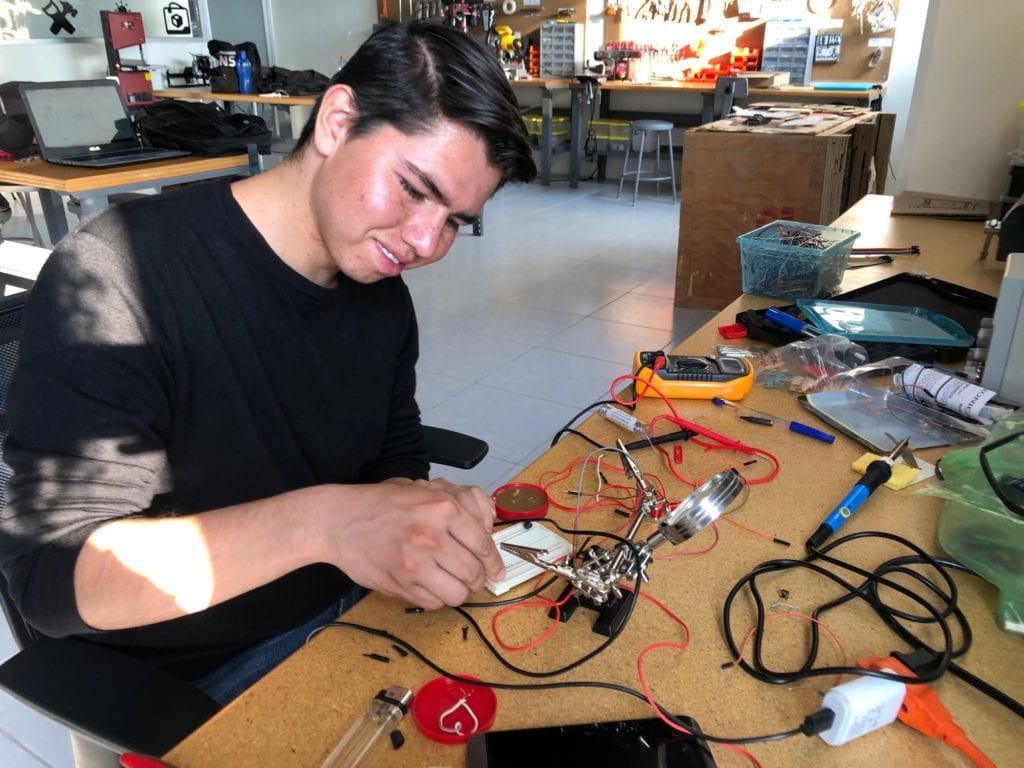
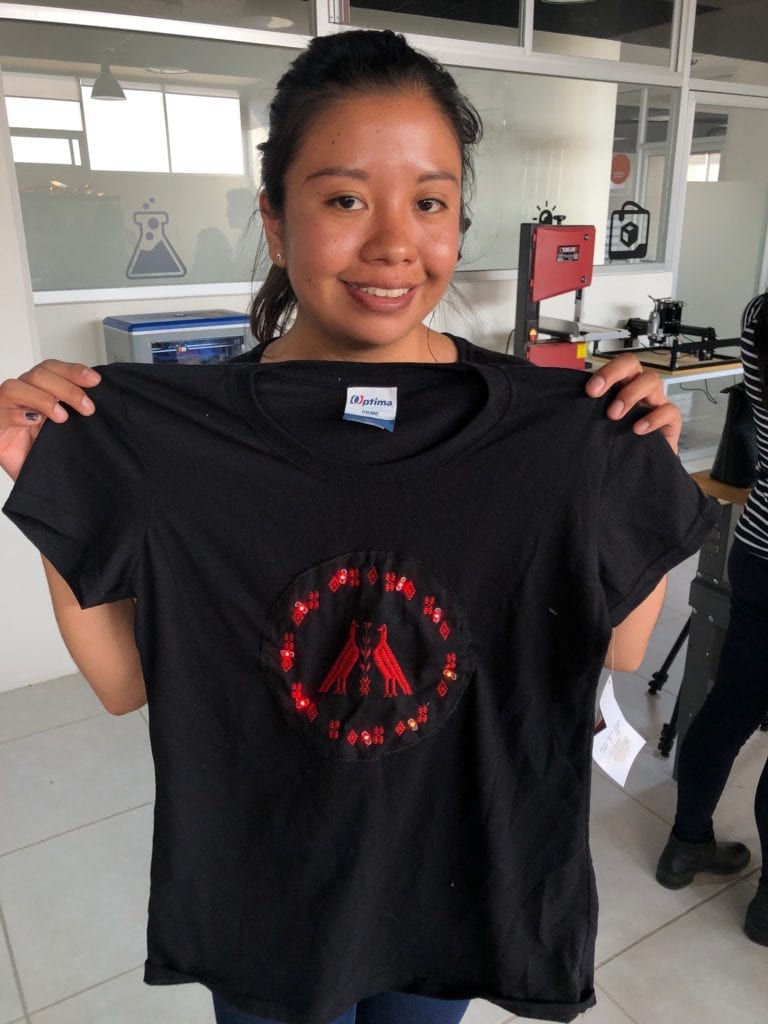
As part of our creative research, we visited several sites in the greater areas surrounding Pachuca including Las Prismas, Atlantes de Tula, local mines, and magic towns such as Huasca and Real Del Monte. Participants used this time to gather 3D data, take video and images for their final prototypes, and gain deeper knowledge to share as part of their final pieces. We also had the pleasure of meeting with art and technology residents visiting from all over the world as part of the local Fronda Arte residency program.
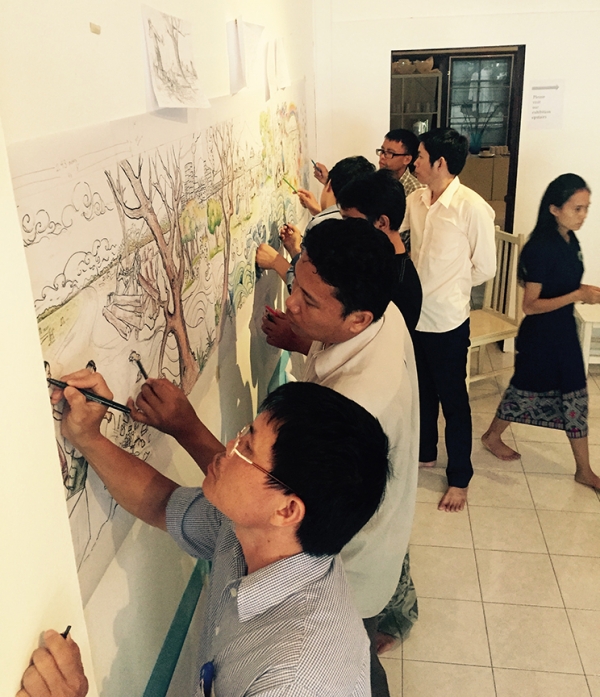
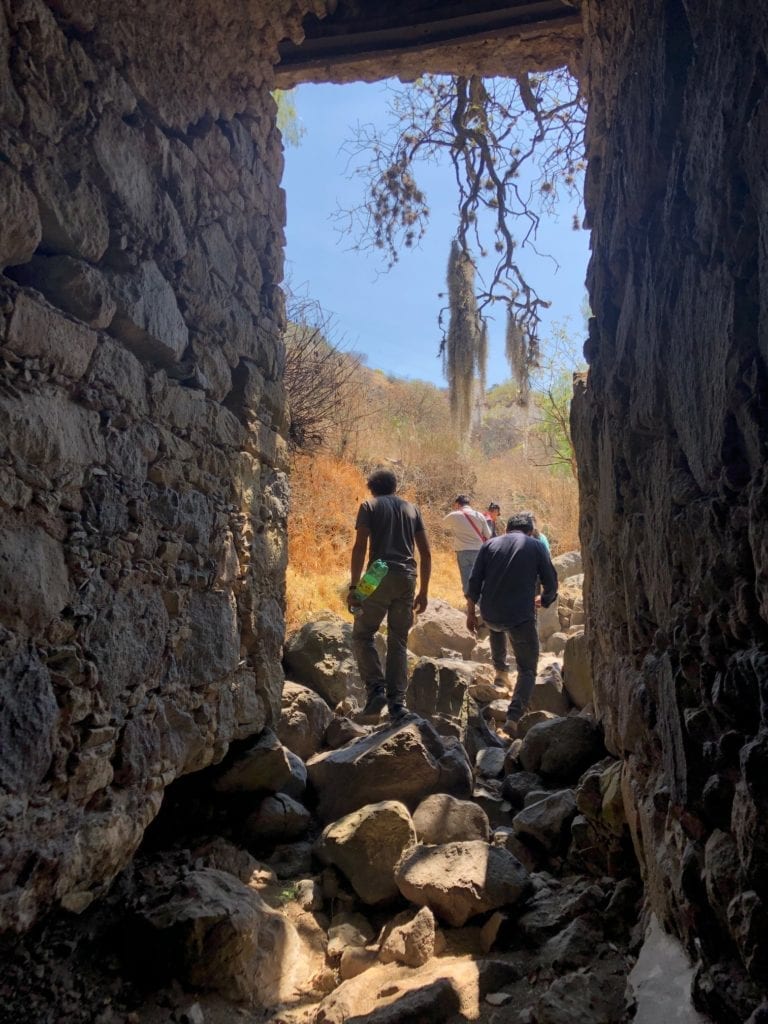
The resulting prototypes were exhibited at CITNOVA where participants shared their ideas with guests panelists and visitors through an Open House. I was incredibly proud of the ideas and projects that each team executed given the brief period of time to learn and absorb a large number of new processes, tools, and technologies.
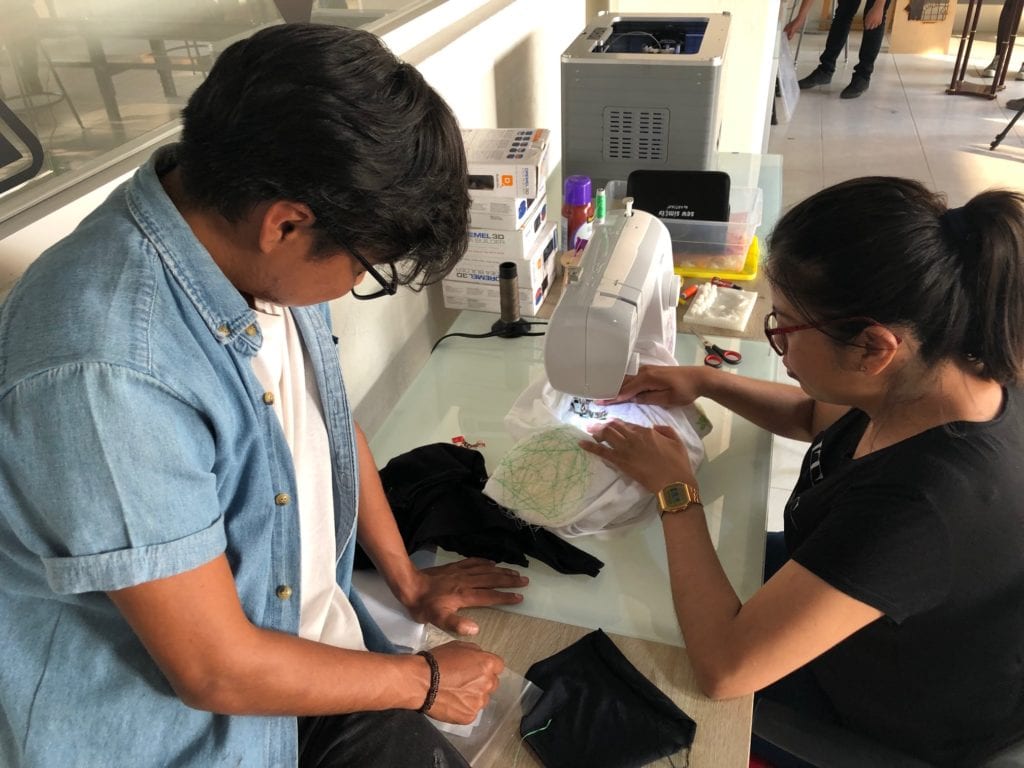

Personally and professionally, I was blown away by these participants who had a deep knowledge and appreciation for their cultural heritage, home cities, and personal histories. Being able to visit many ancient sites was a true gift, as was spending time with this incredible group of people. Our visit to Atlantes de Tula was incredibly transformative for me personally.
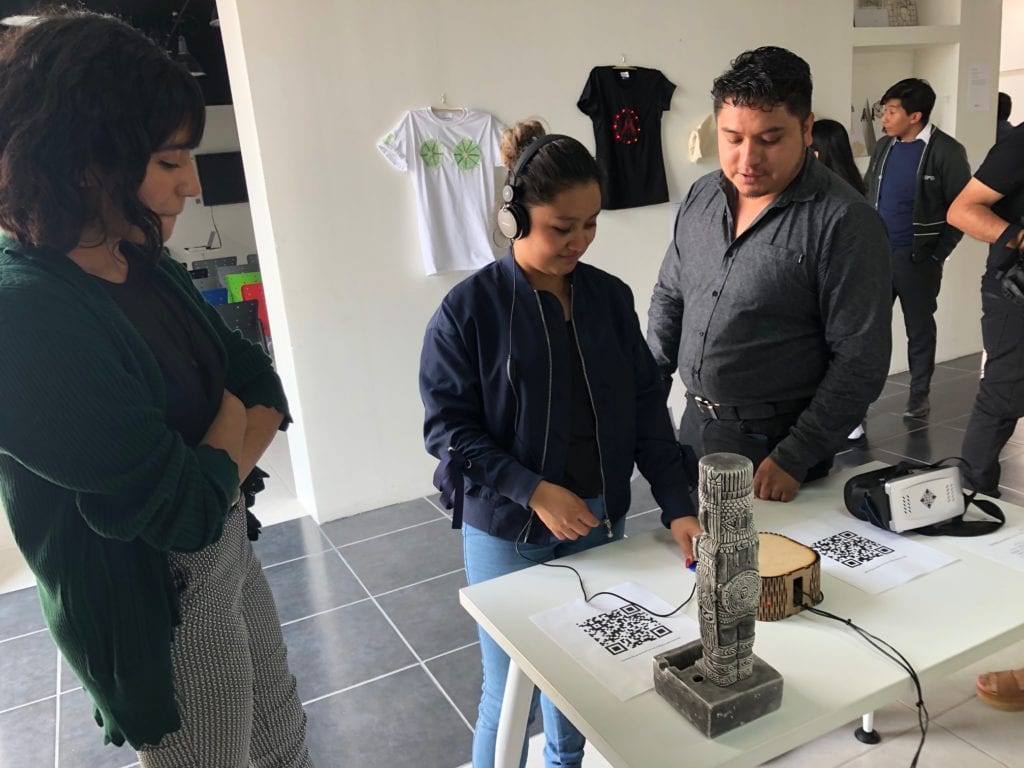
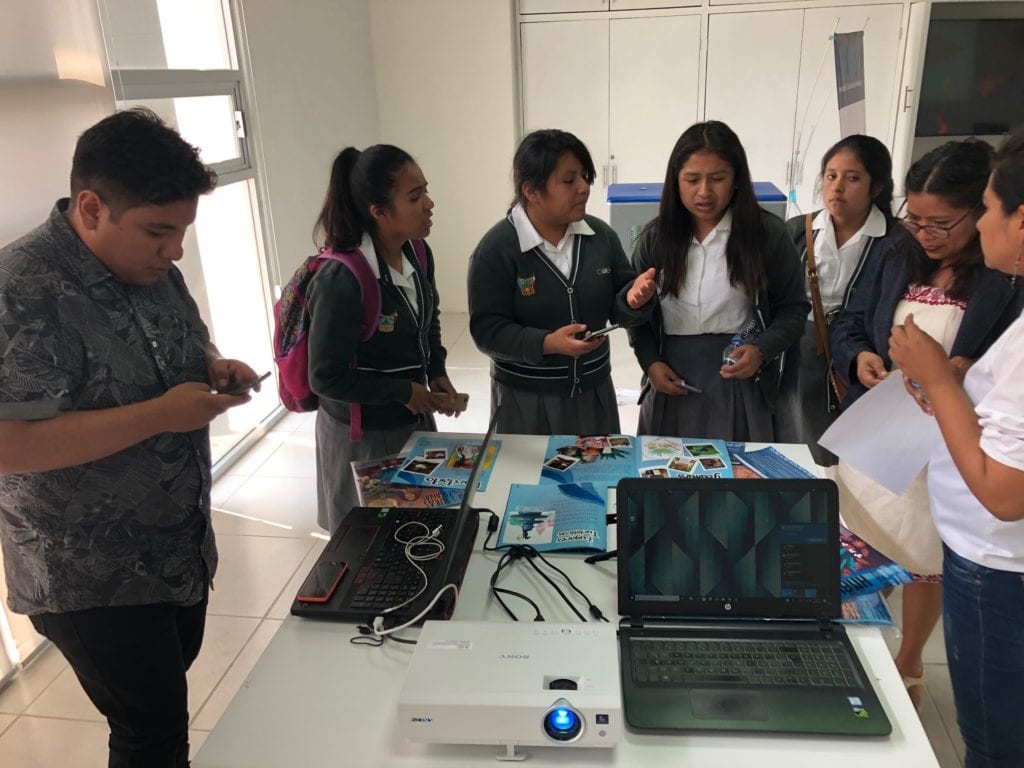
The participants came up with incredible ways to utilize the technical skills that we had covered, including 3D-printing bordado embroidery patterns onto fabric, which blended traditional crafts with new technological approaches. One group explored the rich historical languages present in the Pachuca area by creating prototypes that highlighted indigenous languages through AR magazines and light installations, while another created projects that were visual representations of the history of mining culture through wearable bioplastics. The final group used RFID-embedded objects to create interactive videos of the cultural sites we visited.
This experience was incredibly meaningful, and professionally shifted my approach to considering how new technologies can be used in conjunction with traditional craft in the future. Utilizing new technologies allowed complex issues like cultural identity to become more accessible to a broader public. I am fully confident that the participants from this exchange will continue to develop their prototypes. I look forward to continuing the discussion of these projects online and hope to visit Pachuca again in the future.
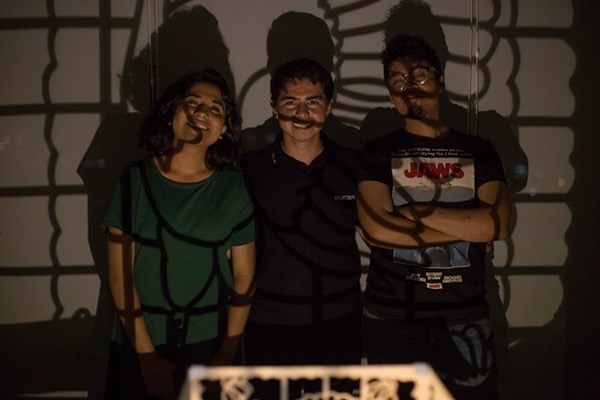
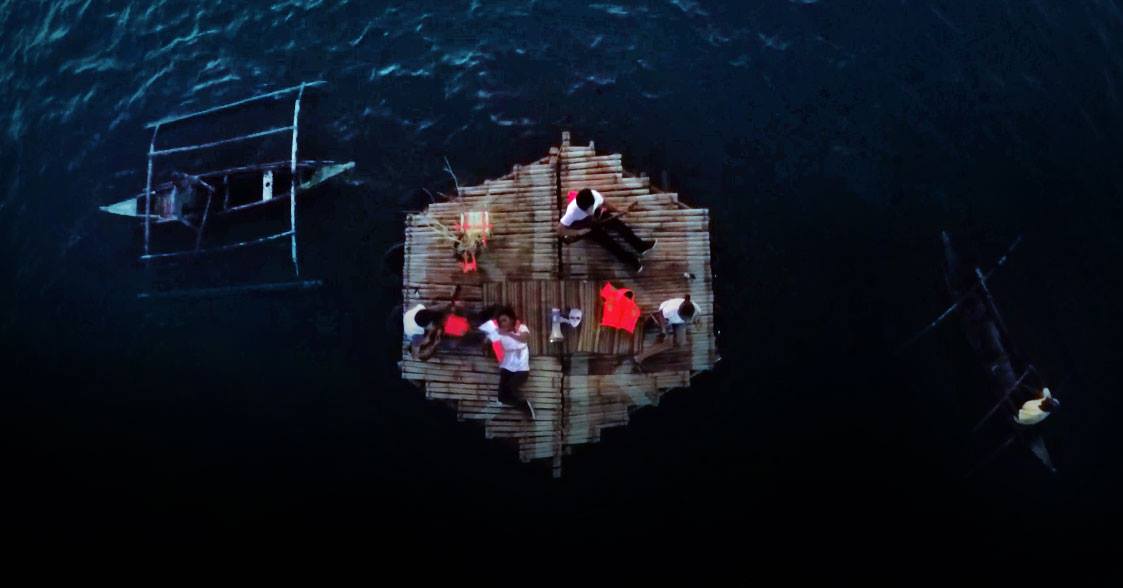
I awoke my first morning to the sound of bells ringing and birds singing. Somehow, my driver had found my little apartment the night before, though this part of Kathmandu, Old Patan, is so ancient that it has no street signs, no street names, and there are no numbers for houses. Places here are referenced by family names or the nearest temples. Streets were developed as footpaths, and only a few are wide enough for a single car to pass through. Dhumbahal House is where I lived, named after the nearest Hindu temple, though there is a Buddhist Stupa outside my kitchen balcony and a Hindu shrine below my living room. They are visited continuously, both day and night.
By day three I’d recovered my lost luggage, met with the Embassy, and walked the mile through the old city to Nepal Communitere: an innovation hub, entrepreneurship incubator, and makerspace that supports a progressive vision for Kathmandu and greater Nepal. The team at NC is a vibrant community of Nepali people, many of whom have spent time in the U.S. or Britain, and I felt at home almost immediately with the delicious snacks and lively conversations.
For my residency, I taught a digital fabrication workshop to 16 people, aged 18 to 34, on the topic of women’s empowerment. All of the participants had laptops, some were practicing artists and others were from leadership roles in their work and community, and very few had digital design experience.
l led each day of the workshop in roundtable discussions with the question: “What does empowerment mean to you?” Some stories were difficult, others inspiring, and I deliberately (and transparently) fostered a safe and inclusive space so the participants and I could co-create a supportive community together. Though everyone had different perspectives, the consensus was that women want more choice when it comes to their bodies, access to education and employment, and who they form intimate relationships with and why. Each day ended with an introduction to 2D and 3D design software and tools to fabricate the components to make art.
Four teams emerged around themes within women’s empowerment: home, career, culture, and personal. When it was time for teams to start planning their projects, my workshop assistant and I tasked teams with describing how a visitor would explain their project to a friend, and to create the work starting with that description. Then we set to enhancing the artistic skills that participants brought with them by adding skills in digital design and fabrication.
In the photo above, the participants and I are visiting a digital foundry to see CNC machines, laser cutters, and vinyl sign making machines.
We had ten days to develop prototypes that would invite the public to add to the conversation around what it means to be empowered for women in Nepal.
There was such exuberant energy from participants that came from the project development! All around me, women were speaking their minds, supporting one another, and the feeling was contagious as others in entrepreneurship and artistic communities starting dropping in to see the work and telling others.
What surprised me most was that these projects were able to extend the safe and inclusive community we’d created so that visitors were now participating in the conversation we’d started during the workshop. Each team developed a project that was participatory in nature. Spectators became participants when the projects were unveiled at the Open House, and it seemed like all of Kathmandu was buzzing with the conversation about women’s empowerment.
Last month wrapped up the ZERO1 American Arts Incubator in Gwangju, South Korea in partnership with the Gwangju Cultural Foundation. Gwangju is widely known as the site of the Gwangju Uprising (or May 18 Democratic Uprising), when the public responded to martial law instituted by the government, the closing of schools, and the banning of political activities with a large-scale civil uprising. The uprising began at Chonnam University with students protesting, and quickly spread with tens of thousands of protesters, hundreds of deaths, and thousands of injuries. This uprising paved the way for the democratization of South Korea in the late 1980s, and the event is a major part of South Korea’s history and is still extremely present for many in the country. Working in this very politically and socially engaged city, it was interesting to learn about the current issues of social inclusion that the participants were experiencing, that ranged from issues like processing trauma in the body to dealing with the complex relationship between younger and older members of society.
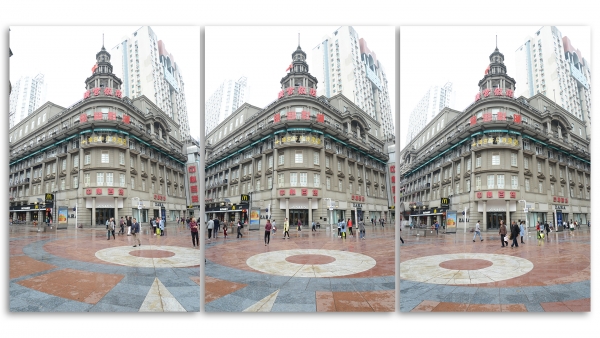
We began with a one week workshop, where we got to know one another, talk through the themes, and learn some new skills. My approach to the workshop was to use the concept of “home” as an entry point to the issue of social inclusion. “Home” is an idea we can all relate to—we have all felt at home at some point, whether it is a physical place, a group of people, or a mode of being, But what makes someone feel “at home” and what does it mean to belong in a space, community, or city? What might a future home look like, if we imagine one that is more inclusive?
Artist Joo Hong visited to talk about her social performances and interventions in Gwangju, around Korea, and in New York Times Square.
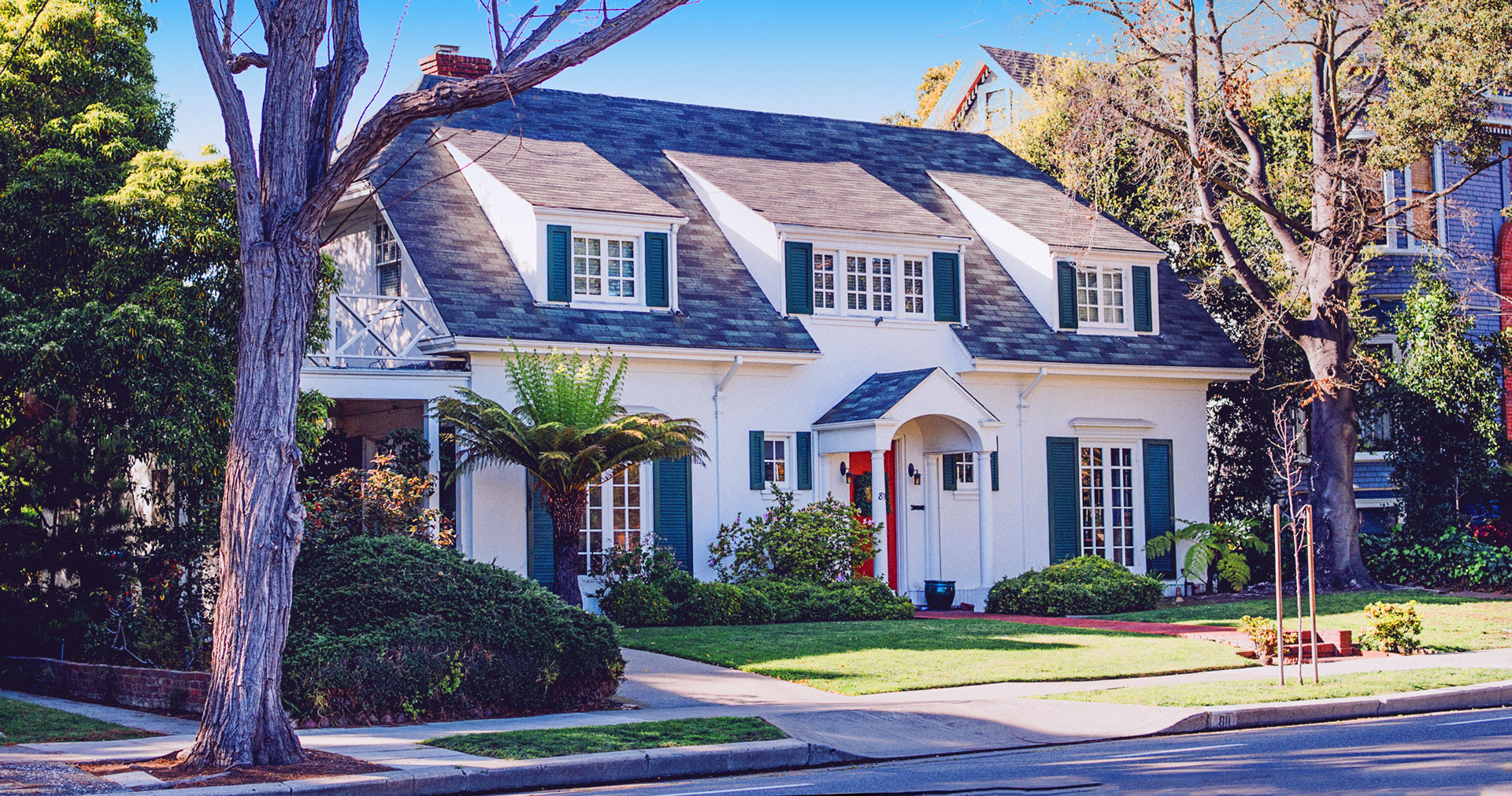
We tried to learn through action and our bodies. Participants brought objects that captured their feeling of home and improvised with them. Through these activities, we got used to the idea of creating space together, negotiating, and imagining. We were building a framework for ourselves.
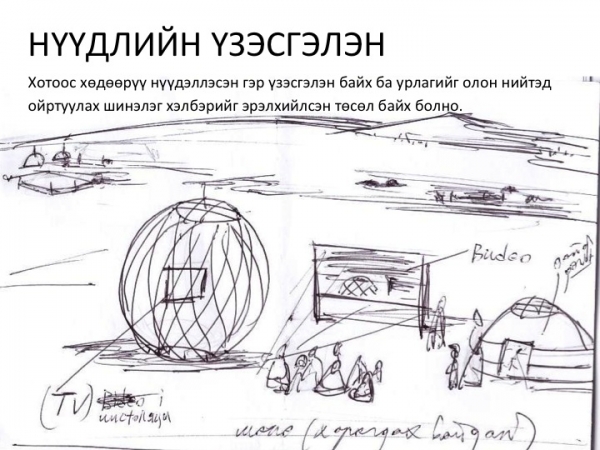
We also visited Yangnim-Dong and thought about the meaning of doing this work in Gwangju today. We toured the beautiful Chinese Holy Tree (Horang Gasinaumu) Guest House and learned about the missionaries and religious and spiritual roots of the city that put a priority on caring for family, city, and justice. This felt very relevant to our themes of home and social inclusion.

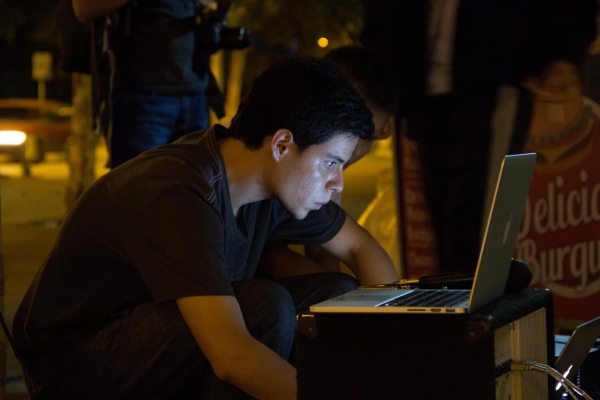
We also spent time learning technical skills to make the projects. We learned coding to create interactive drawings using p5.js. We used machine learning to train simple systems to recognize things like facial expressions, body positions, or basic objects. Then we thought about how to create interactive installations combining elements of camera input, projected content, and audience interaction.
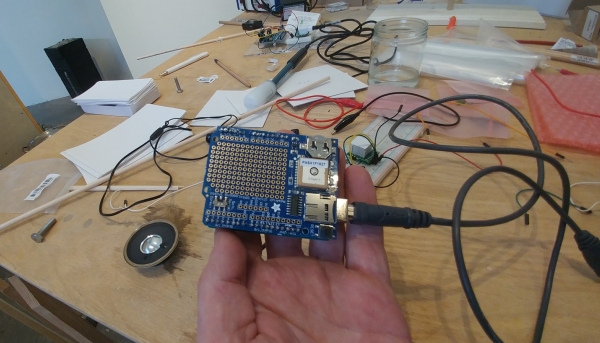

After that busy week, we formed four teams and began developing team projects that would make up one bigger installation. The “Smarter Home” project reimagines smart homes of the future, trying to bring technology into personal space on our own terms. Each team selected an issue within the broader scope of social inclusion to address through a conversation room they created within the larger structure. They then developed one mode of interaction to use as the mechanic for their piece. This meant incorporating machine learning, audio processing, and computer vision techniques to track and respond to the presence of participants.
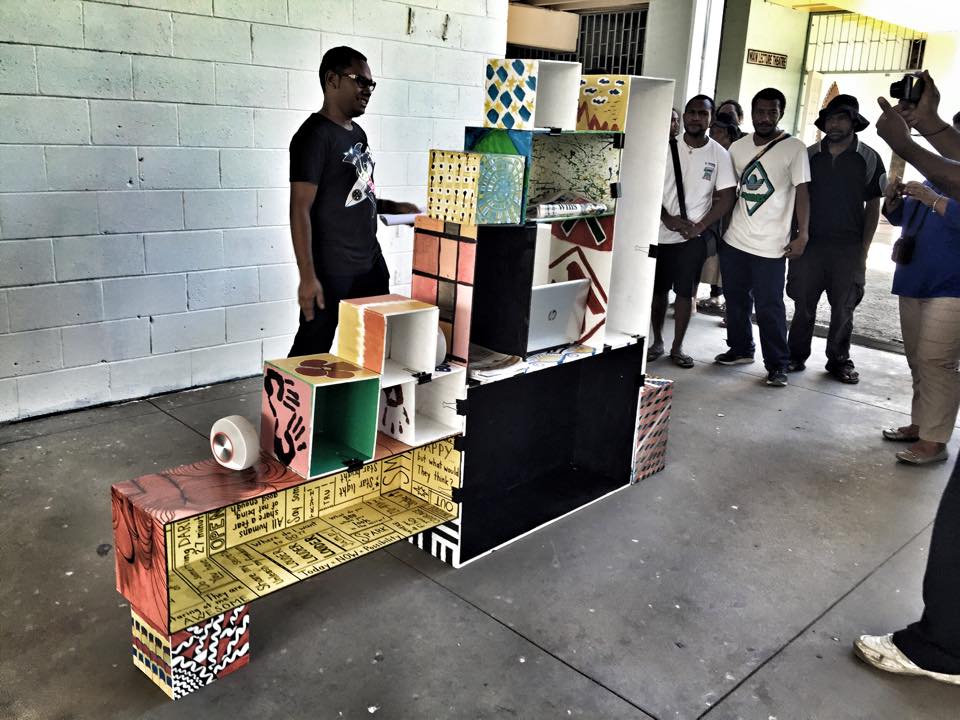
Nawon Paek, Taeguen Lim, Gaeyang Park, and Inhwa Yeom’s project III-iteracy raised awareness about illiteracy and the difficulty some people face in navigating the city. Creating an installation that reacted to eye blinks, they used coding techniques and visual effects as metaphors for understanding different experiences of seeing and reading.

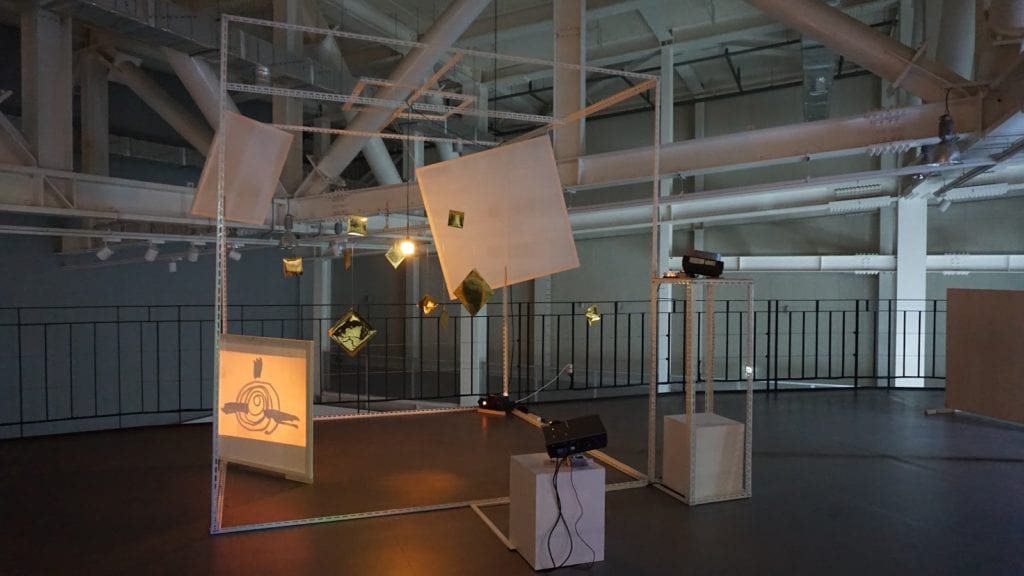
Do Won Kim, Jung Suk Noh, Yun Jeong Kim, Ho Jong Jeong, and So Jeong Yun’s project took on imagined roles of family members to create their project I LOVE YOUt. Expanding on the traditional Korean pastime yutnori, they envisioned it as a means to communicate with family members and understand the history and spirit of Gwangju. It used machine learning to introduce a new game format that combines the past and the future by digitally linking analog games, and presenting the audience with image or text questions to share experiences from different moments in time. The experience drew on a shared sense of sorrow to form a community of hope.
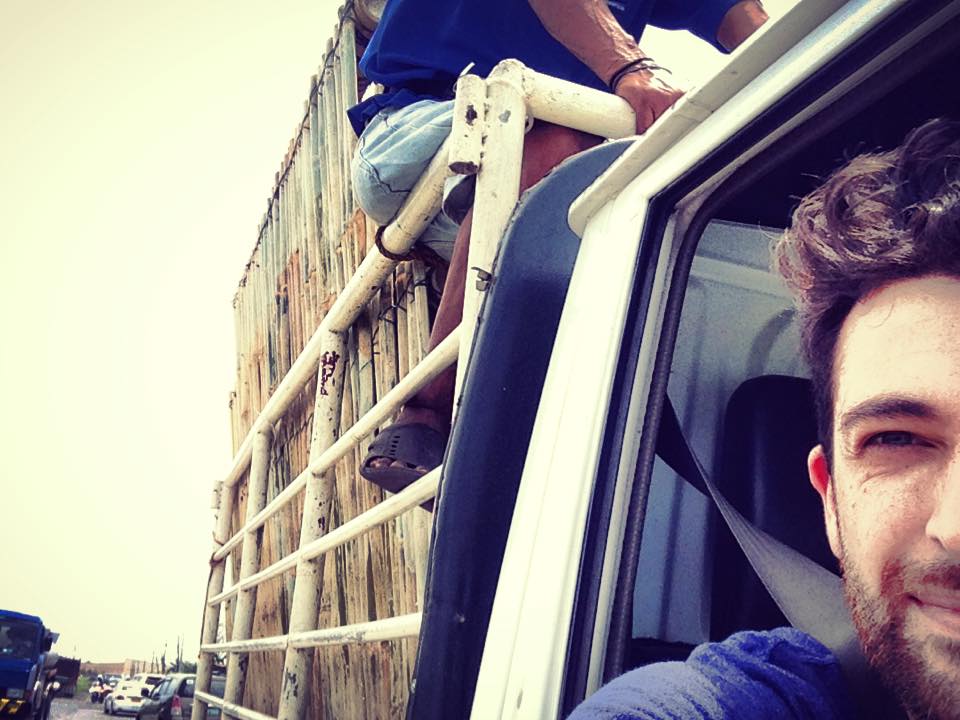
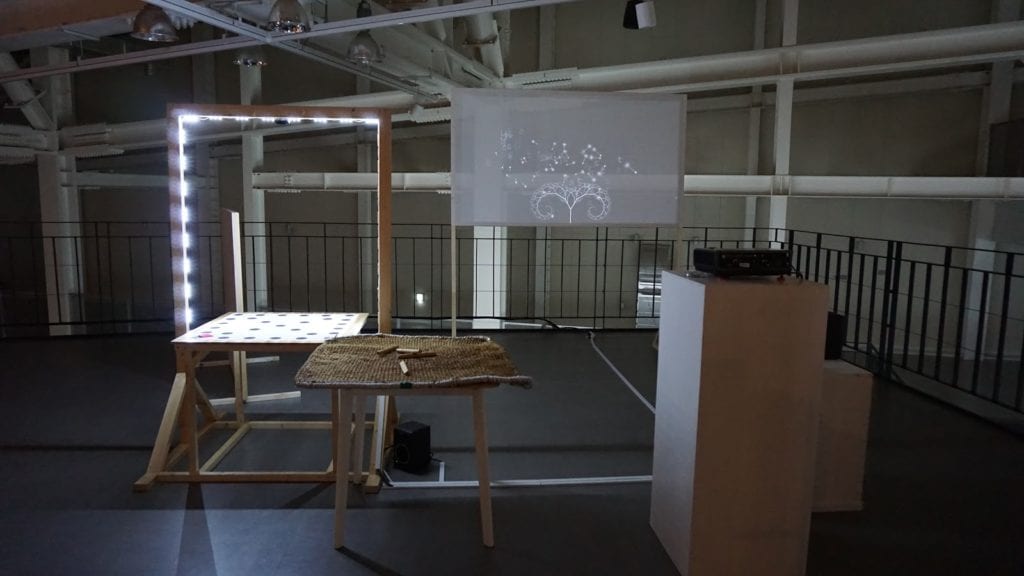
Changwan Moon, Hyewon Kim, and JeongNang Choi’s project Feel-Fill investigated the way emotional pain is experienced in the body. After surveying local community members about their embodied pain, they created an interactive visualization that reacted to voice. When someone screamed in their room, a large portrait of the body would illuminate with mapped projections at the pain points.
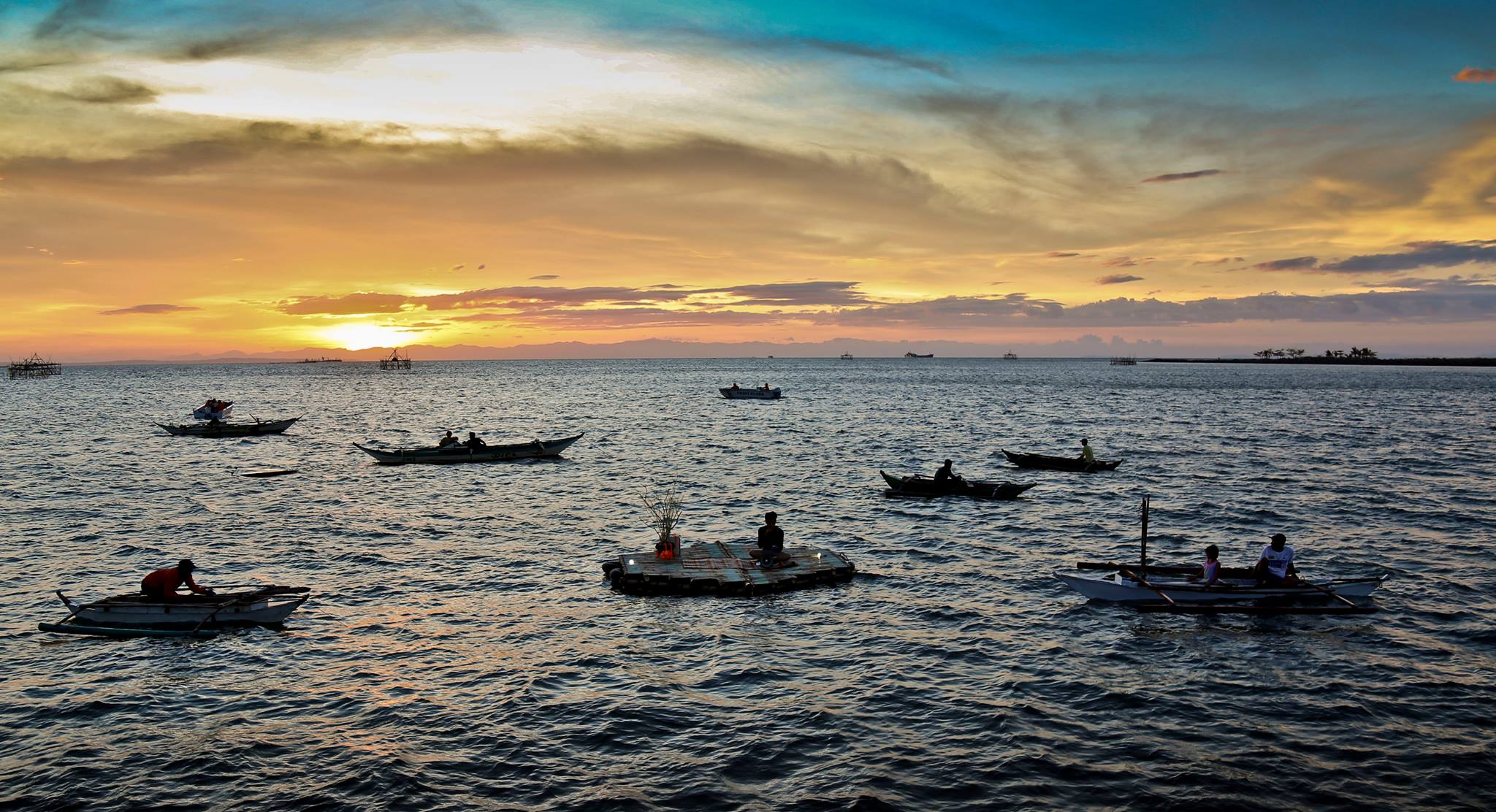
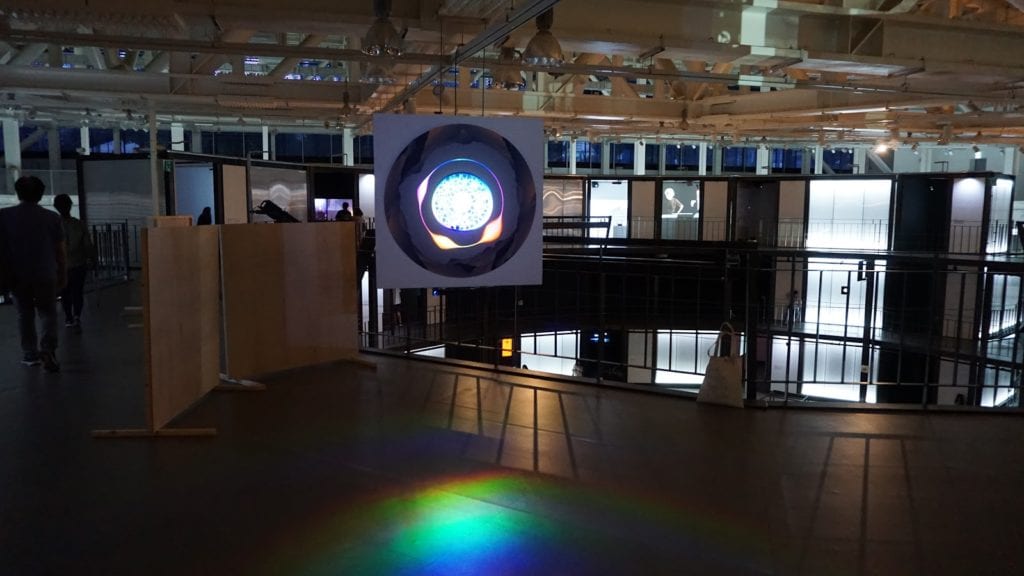
Kitae Park, Minju Do, and Yonghyun Lim’s project How to Understand Your Daughter took on the smaller society known as the “family.” As they put it, “Home is a place where two different social roles collide: between what parents want their children to act like (as a member of the family) and what the children want to act and live like (as a member of a society).” In the middle of the installation is a diary by Minju, one of the team members, onto which a pre-recorded video of her day and her artworks are projected. The audience was invited to react to Minju’s day, experiencing it from her mother’s viewpoint, and respond using their bodies to two options: 1) I am worried about her future, 2) I am not worried about her future. The installation detected the bodily responses and visualized the broader community’s outlook on Minju’s future.
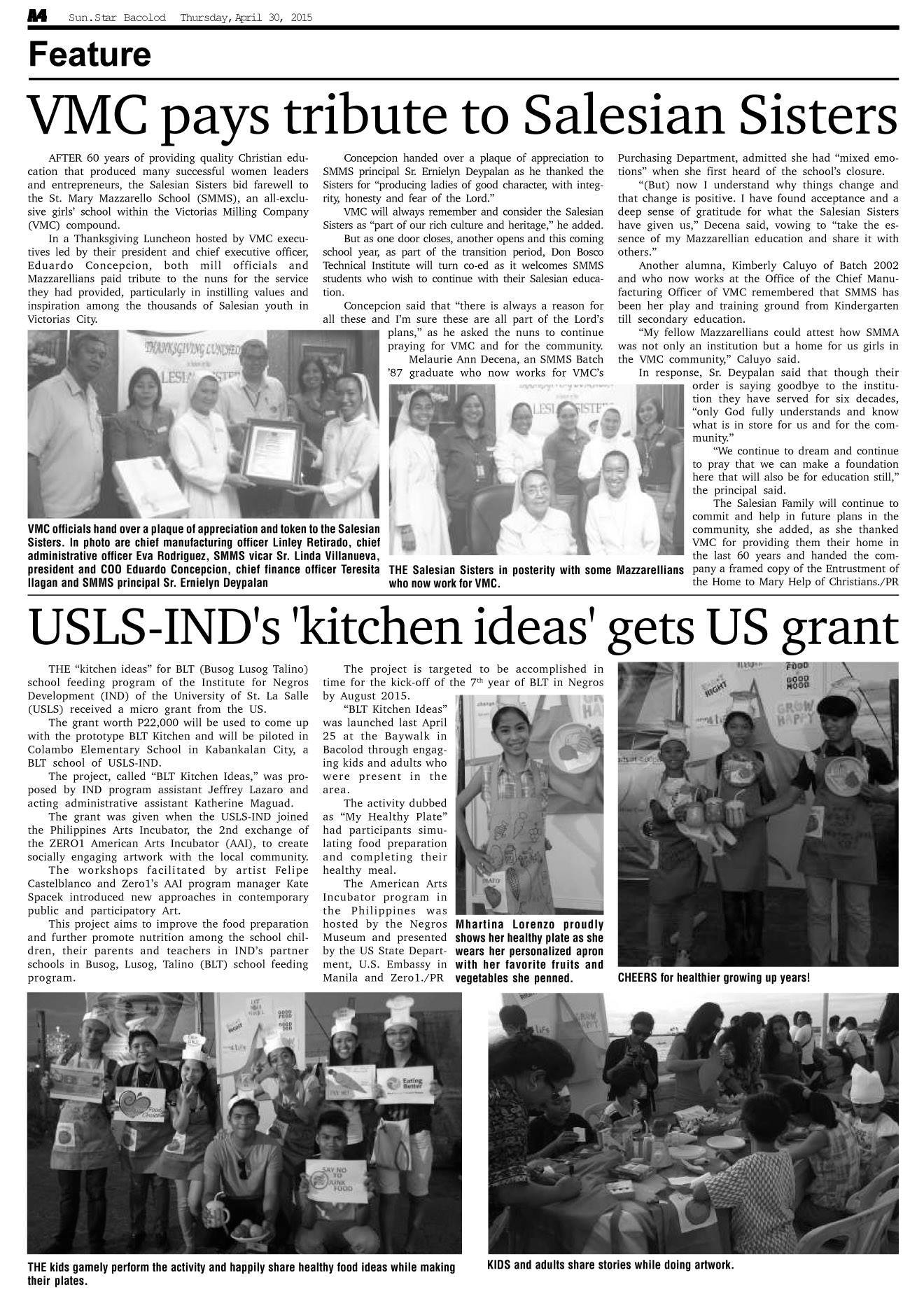
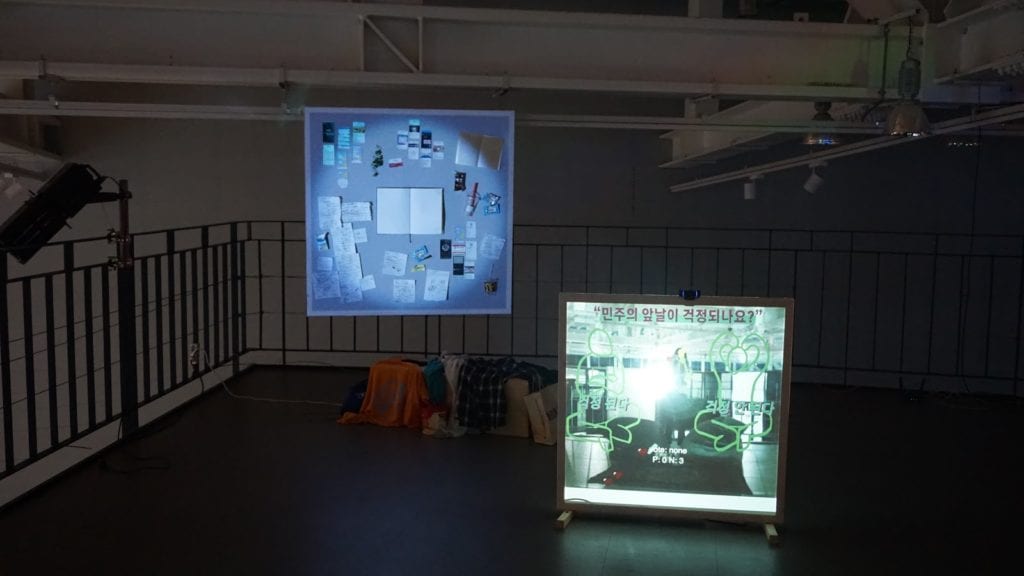
Together, the four works came together into one larger installation that offered our own “Smarter Home / 더 똑똑한 집.” A panel review and open house involving the public wrapped up everything up.

Earlier this month, we had the opportunity to stage a new iteration of this work as part of the International Symposium on Electronic Art (ISEA) exhibition that will be held at the Asia Culture Center. The installation was developed significantly to adapt to a new site, audience, and ongoing goals of the participants.
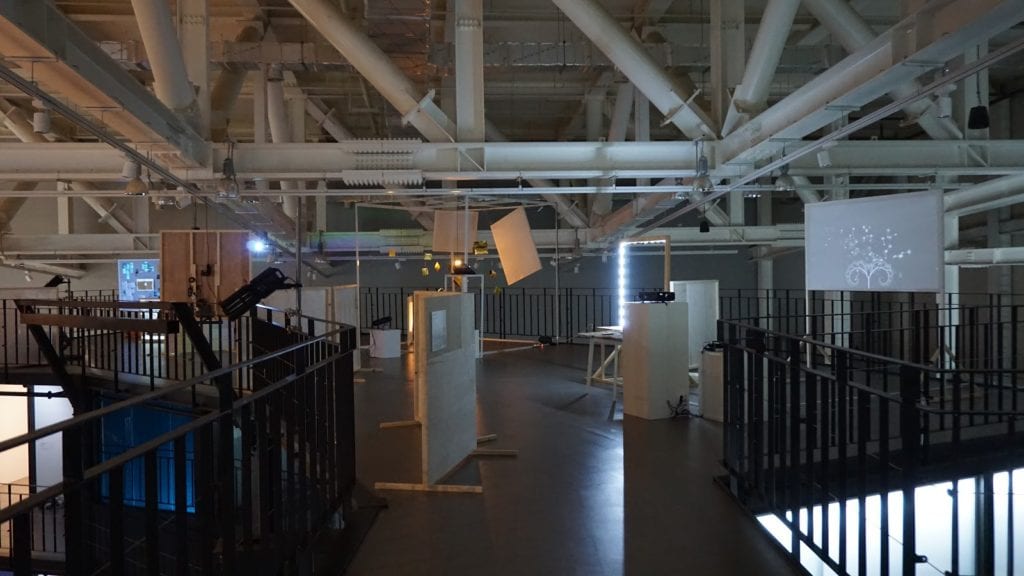
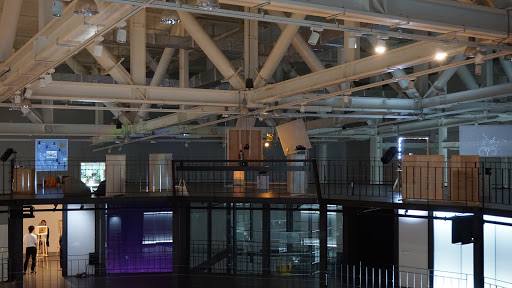
This exchange taught me a lot about communication, which I think is at the core of feeling like you are home. As we navigated language differences, I found my definition of “understanding” expanding. I realized that though we may have different interpretations of what was being said, we could still find places to connect and build together. In some ways, it offered a wider, more forgiving and creative way of collaborating. Each of us were able to bring our individual realities into a loose framework that created something bigger.
I must say many thanks to Inhwa Yeom, our amazing production assistant, interpreter, and team member, the whole team at Gwangju Cultural Foundation, including Yong Soon, JinKyung Jeong, and Jinsil Choi, Shamsher Virk and Maya Holm who provided so much support from afar at ZERO1, the US Department of State for supporting this work, and all the participants who were so creative, committed, and generous with their energy.
What an exhilarating and whirlwind of a month in Istanbul! 16 participants (across a wide range of disciplines) and I explored gender equity and women’s empowerment through participatory design, movement, writing, drawing, skill-building workshops employing different technologies, professional development, and group project development. The month culminated in a spectacular open house and panel review to showcase prototypes we developed together in under ten days. Below, I capture some of the colorful details of the experience…
When I first arrived to Istanbul, it was a rainy day, and the traffic was intense. It took nearly two hours to get over the Bosphorus, passing many billboards with candidates’ faces along the highway. When we finally arrived to Ataşehir, the driver was completely lost amidst the futuristic construction sites of the up-and-coming area where the DasDas Theater and InogarArt is located. It might have been my sleep-deprived state, but the high-rise where I was eventually deposited reminded me of Soylent Green, and was a puzzle to get in.
I woke at dawn to the sound of a loudspeaker calling people to prayer. Starving, I peered out my window to see if any store lights were on before I ventured out bleary-eyed to grab a proper Turkish breakfast. I found one restaurant open with a colorful polka-dot décor, mirrors placed every which way, serving spicy sausage, eggs, and bread.
Restored, I popped into DasDas Theater to meet with my host organization, InogarArt. I was greeted warmly by my amazing team, Esra, Dila, Ayca, and Dodo. We shared some pizza (I didn’t mention I had just ate) and chatted about digital art, materials I needed for the workshops, and they gave me a tour of their beautiful new space. What a gift to be the inaugural project in this incredible facility!
The next day, Senay (my point of contact at the U.S. Consulate) picked me up in a taxi bright and early, and we headed over to the consulate, which was a foreboding building with a mausoleum vibe. We had a lovely talk about the power of pop culture to transform hearts and minds, her time living in New York City, and she introduced me to my first Turkish tea.
We then discussed the logistics for the upcoming artist talk and the program run-down with the founders of InogarArt as well as Keavy and Stephanie from the consulate team, while nibbling on some delicious sweets, and of course, more tea. I also met Ezgi, my amazing translator. We went over my presentation (which I discovered might be slightly controversial given my views on immigration), but freedom of expression was encouraged.
The following day, I gave the artist talk in call-and-response style. I shared some of my past social justice work along with my current networked theatre and dance projects, which was followed by a reception with some delicious tapas prepared by an organization that supports refugee resettlement. I also met many of the participants, who appeared very shy, yet excited about the program.
The next morning, we kicked off the workshops after sharing breakfast (Menemen) together informally.
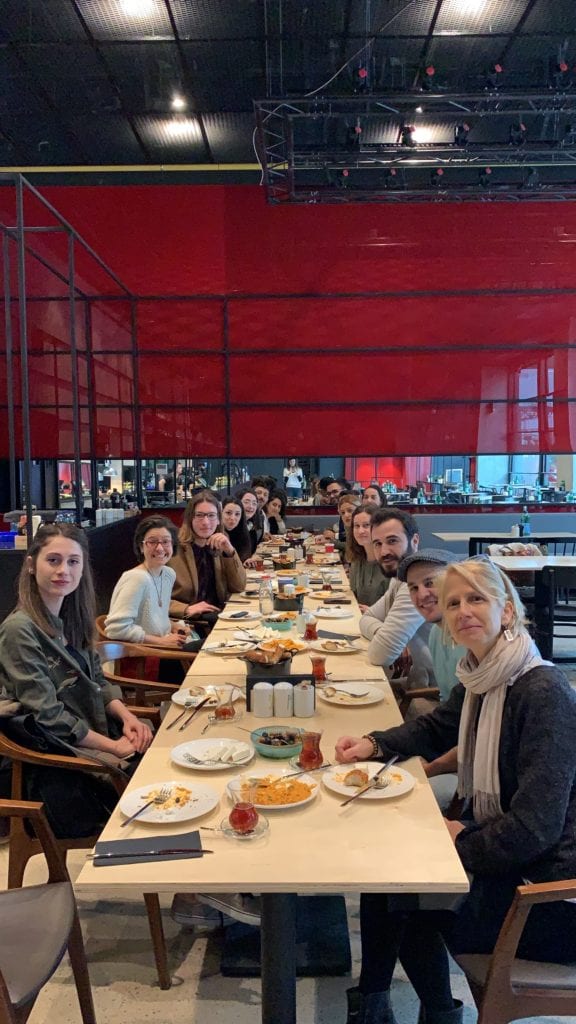
During the first workshop, I started with some ice-breakers and the “5 Whys” to create an intimate and safe space, and I took the participants through a participatory design practice I invented called “play as process” which allowed us to map the social challenge to an art, technology and performance project, to better balance message with engagement.
The process moved participants from the rational to the emotional, then onward to the visual, spatial, and temporal unpacking of the social challenge through systems thinking. In the final stage, participants applied all the accrued knowledge and documentation from the first three stages to the design of a paper and physical prototype.
During the process, participants identified and humanized their target audiences, defined the core values, problems, solutions, and actions associated with gender equity & women’s empowerment, then translated it into a simple narrative with characters and a clear message frame.
Next, through four discrete “imprinting sessions” drawn from French psychologist Clotaire Rapaille, they deconstructed the “culture code” of their issue, which allowed them to see the inherent resistance and challenges in communicating their issue.
Then, they explored mapping, diagramming, and cataloging their issue to begin visualizing the causal systems at play in their issues. With these three prismatic ways of looking at the social challenge, participants possessed all the ingredients for designing an experience using art, technology, and performance.
In addition, I also gave them an overview of the history of art, technology, and performance, and we examined case studies of contemporary projects to build a toolbox of technologies, UX/UI mechanics, and narrative strategies we could use for our concepts.
During the second workshop, I took the group through a multi-modal movement exercise, which involved a series of movement prompts, starting with reconnecting with our own bodies, then doing paired work, and eventually examining the whole ecosystem. The movement exercises were interspersed with drawing and writing exercises, which were intended to locate where our personal relationship to gender equity and women’s empowerment lives in our bodies, and to transform the script. At the end of the day, each participant gave a micro-performance based on their individual relationship to the social challenge.
During the third and fourth workshops, participants were asked to bring personal objects that connected to the issue. We then used these as a starting point for stories, which were recorded and edited. We took 360° photographs of the objects, and brought them into a photogrammetry software to generate a digital 3D model for printing. Next, we moved onto building custom electronics with microcontrollers and sensors to create a “storied object” which triggered the narrative through touch.
During the fifth workshop, I provided the participants with professional development training. I guided them through the process of writing a design document (a standard in the field) and developing a pitch deck. We used these to formulate a proposal and budget. At the end of the session, participants practiced pitching their projects in preparation for the public panel review.
The following day, I met with each of the four teams for 45-60 minutes to map out their technology spec and implementation plan for the remaining 10-day prototyping phase, and assigned tasks to group members. This is when I discovered there were significant skills gaps.
To address this, I met again with each team at SALT (following our field trip to learn about the archive) and elsewhere to enable participants to fully realize their projects by doing individual demos on specific technology.
For example, Group 4 needed to use Unity, a game engine and Microsoft Kinect, so I went over these tools. Group 3 needed a system for generating augmented reality, so I taught them how to create markers and targets using Vuforia. Group 1 wanted to use motion capture technology, so we had a night where we captured movements inside Notch and went over the pipeline for re-targeting to a 3D model, and Group 2 wanted to use IMU data to trigger sound and visuals, so we revisited how to solder and connect various sensors, firmware and deconstructed examples of Arduino & Processing sketches.
And then they were off. During the weekend and following week, I held office hours to tackle specific areas in which each group was stuck, and we went full-force into developing, troubleshooting tech, and installing physical structures in the DasDas Theater. I played a larger role in supporting the development process than I envisioned. And we stayed up until 3 a.m. many nights for the final push. But we pulled it off — the open house and panel review were a huge success!
I was incredibly proud of how much the participants accomplished in a short period of time, considering they possessed little to no technology skills coming in, and they learned in the process of doing. Each night as I walked down the dark steps towards my apartment, I had that positive-productive exhausted sensation.
I was equally surprised that while I had consciously shaped the workshop process around performance, none of the projects evolved into a performance, though I would argue that each work positioned the audience as the performer, and their body as essential to the experience. I also found it fascinating to see how each project was uniquely informed by the interdisciplinary mix of the group.
More information about each of the projects can be found on the AAI Turkey exchange page.
After the opening, where both the public and panelists were able to experience each of the four prototypes, we ushered everyone into the large theater at DasDas for a panel review where the participants pitched the full vision of their projects to an esteemed cross-sector panel of judges: Ahmet Kenan Bilgiç: musician, composer & producer; Melih Akdoğan: GM of D-Park, a tech incubator; Sanem Oktar: serial entrepreneur; Sertaç Taşdelen: founder of tech startup; Şengül Akçar: founder of KEDV (Foundation for the Support of Women's Work); and Duygu Şengünler: co-curator of the Istanbul Biennial. The feedback was generous and incisive.
During the final day, I met again with each group to go over their next steps and a sustainability plan. I recommended that each team bring a programmer and/or creative technologist on board in my absence and created a task list for their development sprints. There were plans to refine the prototypes to participate in a Street Festival when I left. We also discussed having some additional mentorship opportunities for grant writing and pitch training facilitated by InogarArt.
Then I had a lovely lunch (and a chicken dessert!) with Senay on Bagdat Street, and received a beautiful gift from the U.S. Consulate, which is now hanging on the door to my apartment in New York City as protection. And I shared a final meal with my new family to close out our time together where much excitement emerged around certificates of completion.
While I did not see much of Istanbul because our work schedule was intense, and the participants required extra assistance, I did manage to try a wide variety of foods (I fell in love with Tatuni), experience some art, and several of the participants took me on small tours of different neighborhoods.
I witnessed the grandeur of Sophia Hagia, visited the Museum of Innocence followed by a serendipitous tea and wonderful performance in the Beyoğlu neighborhood, enjoyed a midnight hamburger and stroll up to Taksim Square and through the transgender red light district, took the ferry to Kadıköy where I had shared a tea and a lovely conversation via Google Translate with an air traffic controller before giving a talk for the UNHCR, and even managed to get on Turkish TV and squeeze in Hamam after an evening of parkour (I will spare you the video of my Webster!).
I feel as though I was not simply a cultural envoy imparting new knowledge, but a nurturer who quietly cultivated a new family. It was one of the most fulfilling and positive experiences I’ve encountered in my life, and we created a very special bond. The participants even plan to meet monthly as a full group, and have ideas for other collaborative projects.
I left Istanbul with a full heart, appreciative for the experience and all the hidden labor that goes on behind the scenes by Shamsher and Maya to make American Arts Incubator such a unique experience. Teşekkürler!
Source: Jeonnam Daily (“Citizens have a direct say through 'New Media Art',” by Jin-sil Choi, May 29, 2019. Translated from Korean.)
It was a spring day in which the flowers were gradually beginning to fade after blooming. I had been tirelessly pursuing the expression of my story through a medium called new media art. The 2019 American Arts Incubator workshop, although brief, was an inspirational and exciting time. As a project coordinator, I know that the feeling was shared amongst all of the participants.
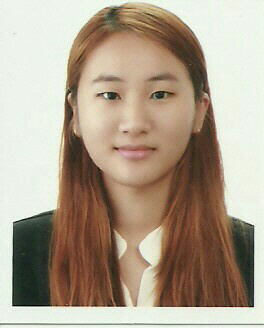
The workshop was organized by the US Department of State and ZERO1, leaders in Silicon Valley’s art and technology scene. The organizations have collaborated since 2015 to send US artists around the world and conduct workshops.
The Gwangju Cultural Foundation was chosen as the intermediary to help locals with diverse backgrounds access workshops. The program enabled participants to receive guidance from an experienced new media artist and professor at UCLA. Fifteen participants consisting of students, those new to artistic practices, and artists had the pleasure of expressing their ideas through the medium of new media art.
Even for participants with experience in the arts, the workshop posed the new challenge of expressing themselves in a third language, coding. However, the lead artist Lauren McCarthy, developed the p5.js software so that anyone could easily understand code. Thanks to the support allocated to each group, the participants became accustomed to the basic ideas, bit-by-bit. Despite the short amount of time and technological challenges, each group created their own artworks. With determination and a strong desire to learn, each team of participants was able to produce a meaningful piece that inspired audience members.
Because these artworks were produced by regular citizens, the pieces were relatable and accessible to the audience. One piece showed a family enjoying their national holiday together by playing Yut Nori, a traditional game. This work reminded viewers about the importance of cherishing family memories.
Another artwork that received praise depicted the tensions between a concerned mother and her 20-year-old daughter. Members of the audience were particularly drawn to, and impressed by, the interactive elements of this work. By incorporating projection mapping technology, the audience could make gestures that influenced the screen. This contributed to a meaningful experience, as each guest shared in the experience of expressing themselves through new media art.
This program demonstrated that new media art is able to express significant stories and ideas. More importantly, it illustrated that the creation of such content isn’t exclusive to experts and established artists, but to anyone who has feelings and opinions to express. This is in line with UNESCO Creative Network's educational values, aims, and objectives. Now there are ways in which people can create evocative and well produced works to express their stories. As a program, it illustrated a lot of possibilities in a short period of time, all while suggesting the direction of future media art.
If these local projects continue to develop and become established into our educational programs, it would be a great resource for citizens. I will do my best to support that development.
Source: Gwangju Daily News (“Do you think of 'media art' as a fresh concept?,” by Jeong Nang Choi, May 23, 2019. Translated from Korean.)
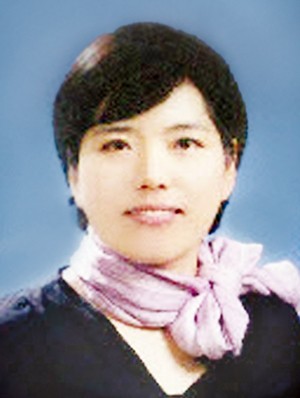
I recently had a special experience involving emerging media art. It was through the American Arts Incubator program, hosted by ZERO1 and the US Department of State. They collaborated with the US Embassy and Gwangju Cultural Foundation to carry out this unique month-long event. It was a workshop in which we discussed matters of societal impact such as social inclusion. As a group, we sought to express our thoughts on these issues through media art techniques.
Many people who have little-to-no experience in the arts, like myself, participated in this workshop because it welcomed ordinary people and artists alike. The artist who lead the workshop was Lauren McCarthy, a professor and researcher at UCLA. She began by delivering a presentation on a coding program that she designed called p5js. By entering data into this program, it enables the recognition of facial expressions, body positions, and objects.
After completing the basic coding course, the participants were divided into teams. Then the teams began to develop their projects in line with the social inclusion theme. They asked one another: “Is there a moment when I was marginalized or excluded?” They proceeded to dig into what the experience was, when it happened, and why. Following, they began a conversation about when they had a sense of belonging or being welcomed.
It was from these discussions that they reached a general consensus and began drawing up their team projects. Due to the diverse range of ages and life experiences among participants, ideas were in a lengthy state of back-and-forth debate. Lauren facilitated and helped to guide participants during the process.
After much intensive effort from the members, the four teams completed their art works. The first team created “Ill-Iteracy”: a system where analog and digital devices could successfully coexist. Team two made “I LOVE YOUt” which focused on restoring mutual understanding and respect between community members through the traditional Korean game, Yut Nori. The third team used surveys to ascertain how people felt and then created digital environments to overcome anxiety and emptiness in their piece “Feel-Fill”. The fourth team “How to Understand Your Daughter”, took on the task of finding unique perspectives on parent-child conflicts.
The four works were displayed for exhibition at Artspace 338 for about 10 days. The opening began with a briefing on each piece, presentations on the works, a panel review, and finally, audience questions that led to intense and in-depth discussions.
Through this workshop, I had the opportunity to meet emerging media artists who live in Gwangju and abroad. I felt pride and contentment in the fact that I was given the chance to collaborate with world-class artists and researchers. I also felt pride in being a part of Gwangju city, 'the pillar of innovative media art'.
The finished works will be displayed and presented again at a special exhibition in the 2019 International Symposium on Electronic Art (ISEA) that will be held for a week at the Asian Culture Center. I hope that researchers, viewers, and artists alike will come to see what kind of emerging media art was produced.
Since January 2017, I have been attempting to become a human version of Amazon Alexa, a voice-activated AI system for people in their own homes. The project is called LAUREN. Anyone can visit get-lauren.com to sign up.
The process begins with an installation of a series of custom-networked devices that include cameras, microphones, switches, door locks, faucets, and other electronics. For three days, I remotely watch over the person 24/7 and control all aspects of their home. I attempt to be better than an AI, because I can understand them as a person and anticipate their needs.
LAUREN Testimonials, 2017. Directed by David Leonard.
This project represents one of the main themes of my practice, examining social relationships in the midst of surveillance, automation, and algorithmic living. In particular this past year, I’ve been focused on the concept of “home.” How do we know when we’re home, and how does technology fit into this feeling?
I’ve been investigating these questions through a series of projects. In 24h HOST, visitors take part in a small living room party that lasts for 24 hours, driven by artificial intelligence that automates the event and is embodied in a human HOST. Prior to the performance, guests register to attend via a website. Their online social identity is scraped and analyzed, and they are assigned an optimal time at which to arrive. Every five minutes throughout the party’s duration, one guest departs and a new guest arrives. I am the host.

Lauren McCarthy, 24h HOST, 2017. Photo by Boudewijn Bollmann.
In The Changing Room, a custom software installation space invites participants to browse and select one of hundreds of emotions, then evoking that emotion in them and everyone in the space through a layered environment of light, visuals, sound, text, and interaction exhibited over the entire space. While it imagines a smart environment that controls feelings, the piece simultaneously invades and cares for the emotions of passersby.
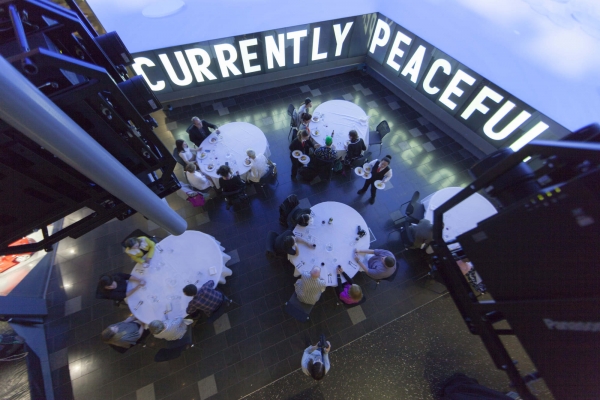
Lauren McCarthy, The Changing Room, 2016. Photo by Kyle McDonald.
We are meant to think smart home devices are about utility, but the space they invade is personal. The home is the place where we are first watched over, first socialized, first cared for. How does it feel to have this role assumed by artificial intelligence? Our home is the first site of cultural education; it’s where we learn to be a person. By allowing these devices in, we outsource the formation of our identity to a virtual assistant whose values are programmed by a small, homogenous group of developers.
I’m looking forward to bringing these research themes to Gwangju, South Korea next month as part of the American Arts Incubator. Working with a group of twenty local participants, we will tackle the issue of social inclusion. Nearly 96% of South Koreans identify as ethnically Korean, which provides a unique challenge to addressing inclusion, and is just one challenge in the broader picture of diversity. Other aspects we will consider include disability, gender roles, and identity in the context of the May 18 1980 Democratic Uprising that began in Gwangju.
It’s obviously tricky to come into a place as a visitor and try to talk about social inclusion and identity. So I am planning to do a lot of listening and learning. As a starting point, we will use the concept of “home.” Home is an idea we can all relate to—we have all felt at home at some point, whether it is a physical place, a group of people, or a mode of being. But what makes someone feel “at home” and what does it mean to belong in a space, community, or city? What might a future home look like, if we imagine one that is more inclusive?
We will create an interactive installation driven by machine learning that represents our group vision of a future smart home. Rather than imposing values and protocols, this home will aim to create inclusive spaces for open conversation and freedom of expression. We will also visit some “homes” around the city of Gwangju, and challenge our ideas of what form and place home needs to occupy. To build the installation, we’ll be using a tool called p5.js, which is designed to “sketch with code” and learn coding through making art.
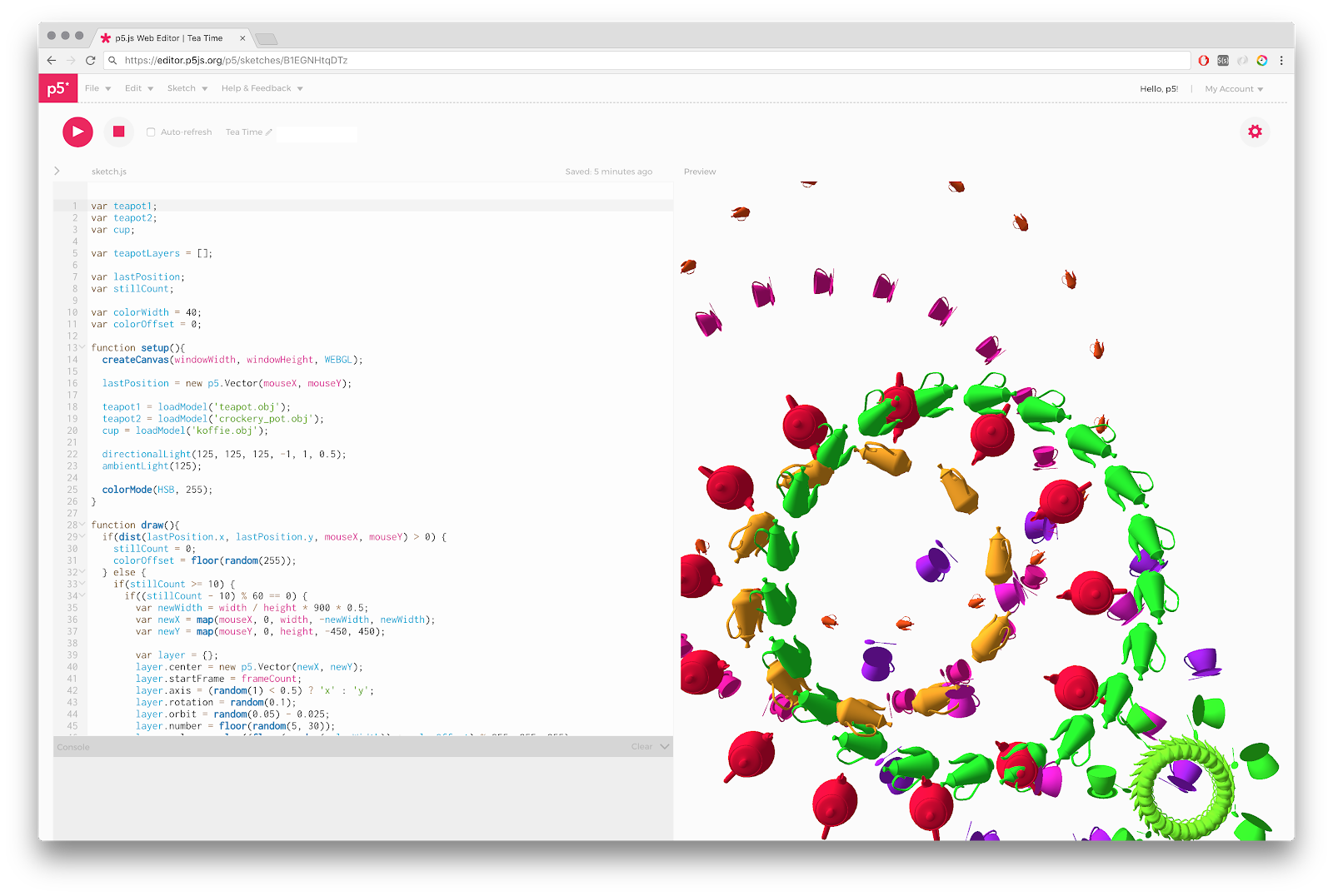
p5.js Web Editor. Photo by Lauren McCarthy.
For this month-long project, I’m partnering with the Gwangju Cultural Foundation. They are an organization that is very tied into the local culture and arts, and they’ve been extremely helpful as we prepare for the workshop and incubator.
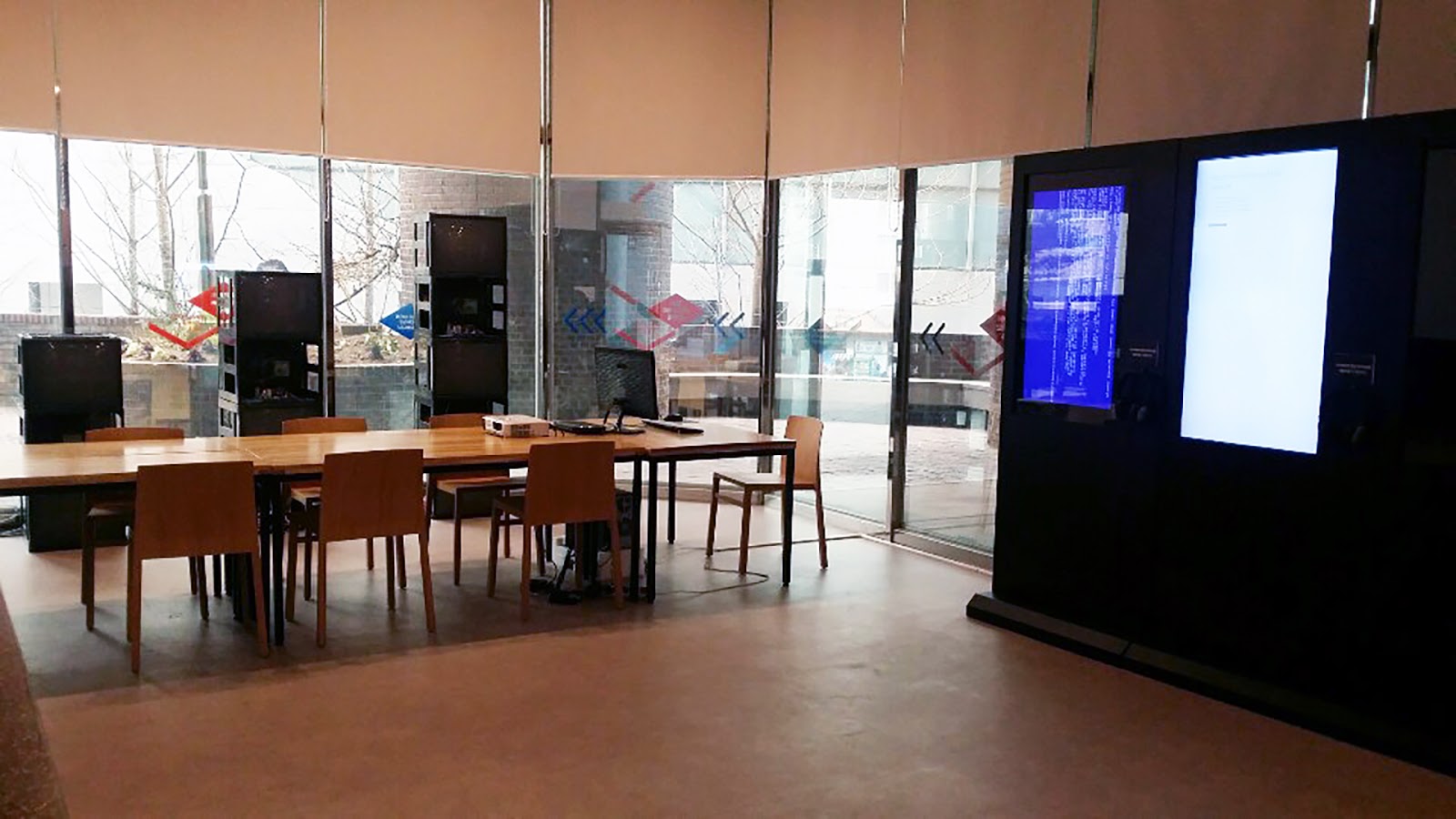
Gwangju Cultural Foundation workshop space. Photo courtesy of Gwangju Cultural Foundation.
I’m looking forward to getting on the ground and learning all I can. If you’d like to follow along, you can join our Facebook group. We’ll have an open house at the end of the exchange, where the final installation and team projects will be on display from May 10-11, 2019.
Heidi Boisvert, [radical] signs of life. Camera, Jim DeSeve; Editing, Yoni Turkienicz.
For the past 15 years, I anticipated future tech trends and used emerging media and technology to support social justice campaigns addressing violence and advancing values of equality and justice.
I’ve created animations to raise awareness about unfair immigration laws, video games to celebrate pluralism, and even location-based augmented reality apps to change perceptions around homeless (well before Pokeman Go).
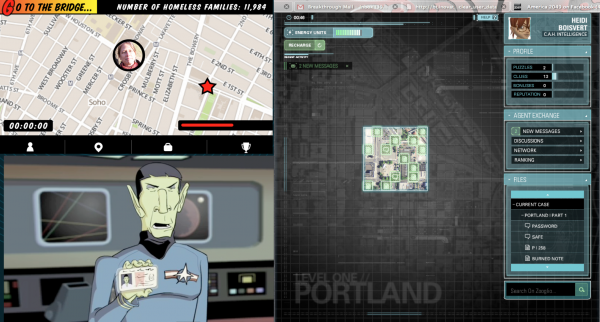
Heidi Boisvert, Experience & Game Designer on @home (upper left) for the Kindling Group, Creative Director, Writer & Producer @Don't Deport Me Scotty (lower left) & Creative Director, Game Designer & Producer, America2049 (right) for Breakthrough.
Then I had a crisis of faith. I felt the tools I was creating to shift hearts and minds were actually eroding key areas of the brain responsible for critical feeling.
This awareness instigated my search for an antidote, which redirected my creative practice towards large-scale networked dance and theatre in an attempt to restore connection with our bodies, and one another by bringing people together in socio-collaborative spaces to play.
It also led to a collaboration with Marco Donnarumma to co-design and prototype a biocreative instrument, the XTH Sense—a wearable, wireless biophysical sensor that detects and captures mechanical soundwaves produced by musculature contraction to re-stimulate what I see as our (technology-) numbed biological selves.
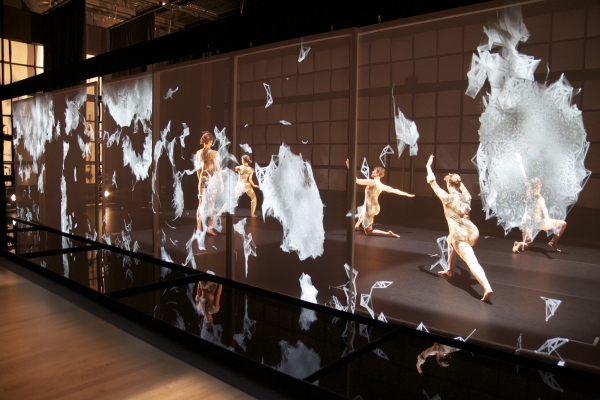
Fascinated with the potential role the body could play in social change processes, I started to ask questions about whether we could decolonize our somatic system through aesthetics, and if the interplay between ghost stories and ritual could catalyze collective effervescence. I wanted to bring movement back into movement building.
During this time, I also discovered that many activists-artists advancing social justice (myself included) were “walking wounded,” often seeking to redress issues in our communities that reflect our own unaddressed trauma. In the absence of truth and reconciliation in the U.S., I wanted to create a shared space for communal healing through a performance devised not from familiar tropes but from the physicality of the storytellers’ bodies, fostering the examination and evisceration of the legacy of lived, intergenerational, and epigenetic trauma stored in our collective and individual bodies.
The body is an archive of our stories, but trauma is not stored as a traditional narrative with an orderly beginning, middle, and end. Instead, trauma is stored as flashbacks that contain fragments of experience, isolated images, sounds, and physical sensations (fear, panic), continuously re-enacted within the body, wreaking havoc on our immune, muscle, and nervous systems.
The impact of systems of oppression—racism, misogyny, poverty—are pervasive. When experienced chronically, the cumulative effect is life-altering, intergenerational, and epigenetic. Because trauma is a contraction held within the somatic system, we are fundamentally "shaped" by terrifying experiences; they inform our worldview and impact our sense of identity, intimate relationships, physiology, emotions, behavior, perceptions, and feeling of belonging. Facing—and healing from—trauma is essential to building effective movements and catalyzing systemic transformation.
Trauma, I believe, is also at the root of the social challenge I will be working on in Istanbul, Turkey, which focuses on gender equity and women’s empowerment.
In preparation for my trip, I have done a fair amount of research on the issue from a socio-cultural and a political perspective. What I have discovered thus far, is that despite legal reforms to ensure equality between women and men in political and civil rights instituted in 1923 when the Turkish Republic was founded, and recent legislation adopted in the 2000s aimed at protecting women from domestic violence and eradicating gender-based discrimination, implementation and enforcement of laws has not been successful. Women in Turkey only make approximately 44% of the earnings that men make, and 38% of married Turkish women have suffered abuse from their husbands. Turkey’s overall gender gap places it 130th of 144 countries. It also ranks 109th in educational attainment, and 129th in economic participation and opportunity.
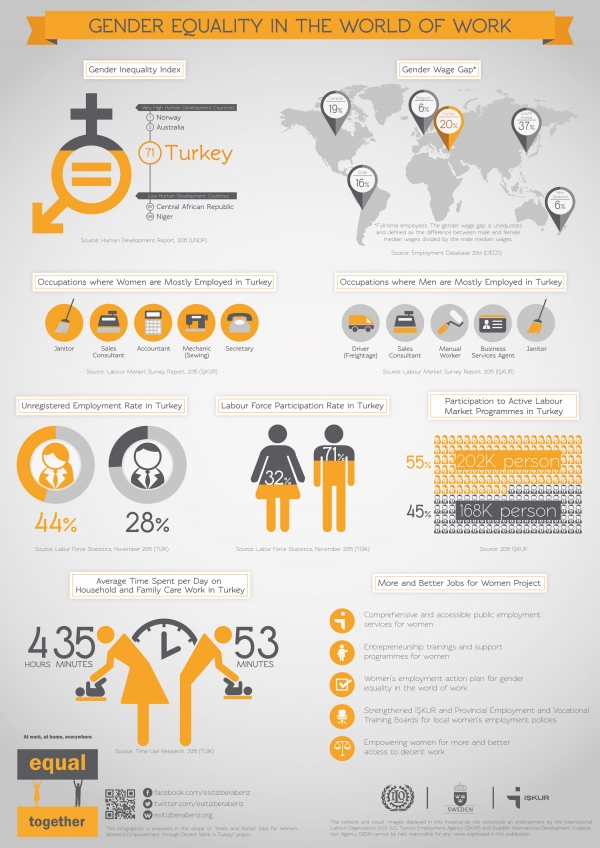
Generalized statistics, however, erase the somatic markers, the deep patterning of residual trauma left in the body by heteronormative, patriarchal structures, which often undermine women’s capacity to lead full, healthy lives.
Dance and performative gesture have the potential to rescript our nervous system and postural signatures through breath, postural realignment, and movement. I have conducted research on movement and the neuromuscular patterns of emotion. Based on my research, I believe people develop deeply unconscious physical postures (neuromuscular and energetic) as children when the limbic system is forming (ages 3-7), which can give rise to embodiments of feelings and chronic mental states.
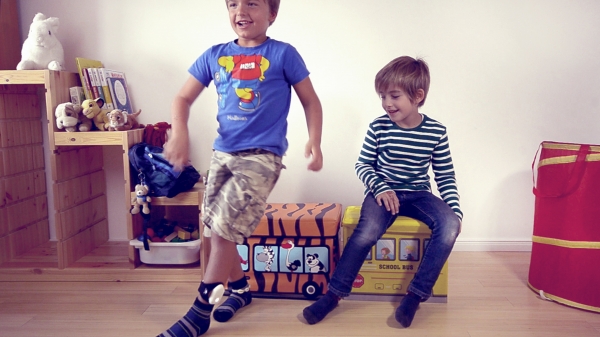
Our unique postural signatures often inhibit feelings that are difficult for us to bear, yet, like much of our physical life—sensations, feelings, gestures, movements, contractions, releases, expansion—operate outside of conscious awareness. If motion emerges out of emotion, then the opposite is also true: we can transform emotional states by activating new sensory-motor routines through free, unguided bodily expression. Through music and imagery generated from the inaudible sounds of dancers' inner bodies (somatic and autonomic nervous system), we can compose the fragments and re-animate the life force within each of us—artists, performers, audiences—that is often blocked or shattered through painful lived experiences.
This is what I intend to explore in Istanbul with a community of 20 women and youth from a broad range of backgrounds and skills. Together, we will transform deeply embedded scripts lodged in the physical body in order to dismantle cultural patriarchy.
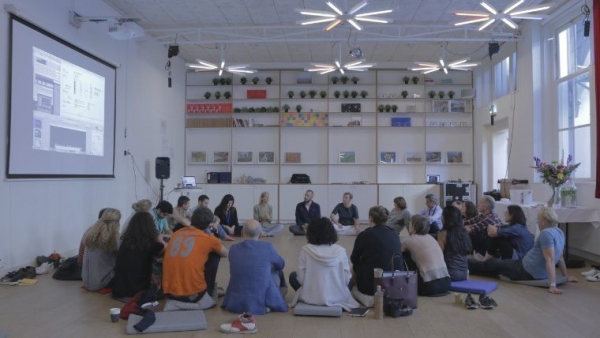
To begin, I will use “play as process," a methodological approach I invented and have iterated upon in creative partnerships with various NGOs, cultural and educational organizations, across a host of issues. This four-part co-creation process will allow me to understand the socio-political context and how participants understand and interpret this social challenge. It will also ground me in participants’ concerns in art/design terms, so I can shape the multi-modal movement workshop and micro-performance process around what emerges.
The multi-modal workshop will consist of a 4-part co-creation process culminating in a short mixed-media performance. Participants connect personal experiences of trauma to a collective narrative by transforming embedded somatic scripts and historical patterns into live drawings and music, all generated from their body data. Movement prompts enhance somatic awareness, create new sensory-motor routines and establish a shared gesture vocabulary from which we’ll build choreography. Story circles create content for a database of images and storied objects triggered through capacitive sensing.
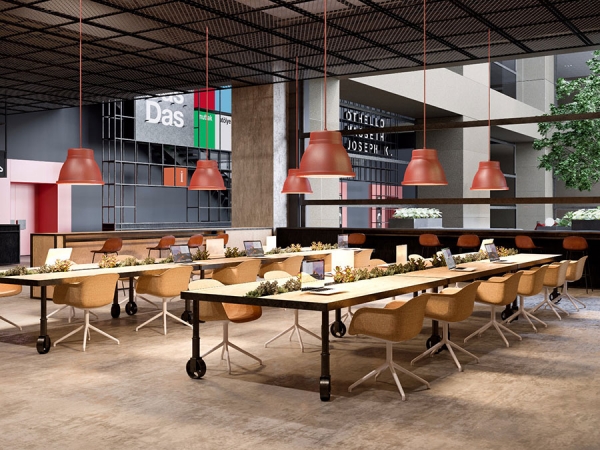
My host partner, INOGAR, is a forward-thinking and highly interdisciplinary organization. They define themselves as “a new generation incubation center that combines innovation and enterprise culture with civil society, private sector, sustainable development, culture-arts and technology.” In doing so, their aim is to lead the way to sustainable development, creativity and technology-based transformation of the entrepreneurship ecosystem in Turkey.
I am thrilled to be based at their newest location at INOGAR/Arts and DasDas Theatre, located on the Anatolian side of Istanbul, which just opened a couple months ago.
During the month long exchange, I hope to teach participants how to build biophysical sensors, extract data, and use it to interface with various open-source software systems to generate live visuals and audio. In addition, we’ll play with show control systems for networked performance, and use a game engine for projection mapping. These skills can be applied to a host of fields, such as interactive installation, game design, live events and hardware development.
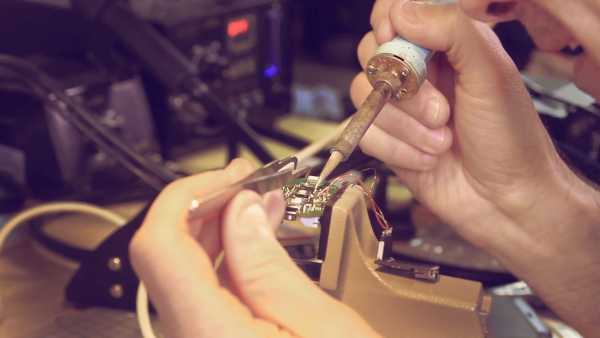
For my own self-knowledge, as I conduct a deep dive into curriculum design for the workshops, I have been reading up on Ataturk and the current government, as well as some quintessential Orhan Pamuk and Turkish ghost stories. In addition, I have been watching a lot of Turkish films (my favorite is so far is Aşk Tesadüfleri Sever), a documentary about different musical styles, and binging on a couple of telenovelas recommended by friends.
During my stay I hope to immerse myself and all my senses in the rich palimpsestual history and culture. I want to try new foods, listen to live music, go see dance, theatre, film and art, have random conversations and simply get lost on a disorienting, psychogeographic dérive to experience the unexpected. In short, I will be as fully present, embodied and alive, remembering that every encounter is a teachable moment, inviting me to challenge my assumptions about perceptual reality.
As I prepare to embark on my journey to Egypt to begin the American Arts Incubator program in collaboration with ZERO1 and Alexandria Creativity Center, a year's worth of preparation is finally coming to fruition. I have been researching the Nile delta and its intricate system of canals and cisterns as well as the growing ecological and social challenges facing this ancient coastal city. From sea level rise to flash floods to water polluted by garbage waste and algal blooms, Alexandria finds itself balanced on the precipice of a global ecosystem in flux.
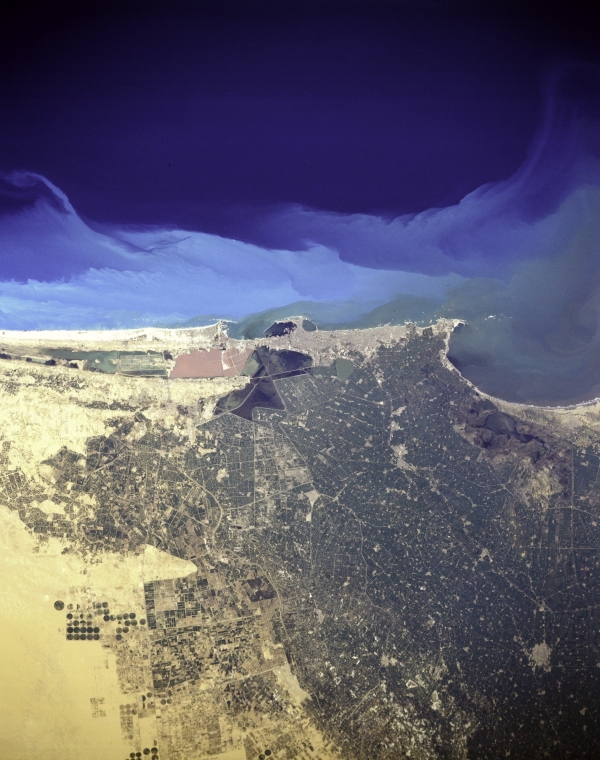
I am drawn to this unique opportunity in search of new collaboration. The community of Alexandria is thousands of miles from my home, yet it faces the same need for innovative approaches to environmental sustainability. By bringing together individuals from a variety of disciplines, backgrounds and socioeconomic levels, we will share our perspectives, histories and vocabularies. The goal is to build trust, fostering cross pollination and friendship across cultural boundaries.
My past experiences leading community events across the boundaries of art, science, academia and local government as well as my work building interdisciplinary teams within the university have prepared me for this new challenge abroad.
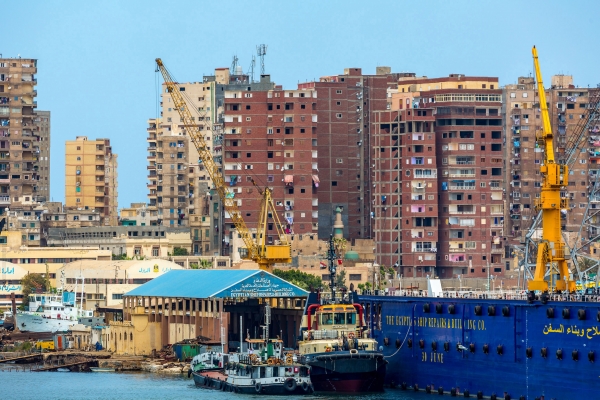
Through deep listening, storytelling and sharing of both historic and emerging technologies, we will build bridges across language barriers, stereotypes and cultural differences. Environmental intervention systems will be designed to make the invisible visible. These ecosystem first aid kits will include data-collecting sensors, audio and video field recorders, digital microscopes, 3D scanners, battery powered pico-projectors and more. They will be modular by design and will include local materials and technologies that can evolve to meet the needs of the communities that they serve.
In the end, these tools are starting points for cultural and environmental empowerment, constructed with an open framework in mind — a system that can adapt to meet the challenges of a planet that needs new ideas and ways of being.
These teams consisted of a broad spectrum of the Alexandria community, with individuals ranging from ages 19 to 60, and a broad spectrum of professional backgrounds, from students to professors to artists, engineers, and biologists.
These photos shot by lead artist Gene A. Felice II and official project documenter Maged Makram give a unique perspective on the duration of the various workshops and team collaborations that emerged throughout the four-week experience.
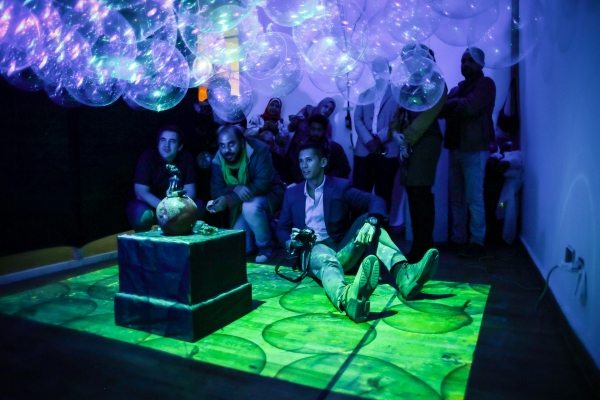
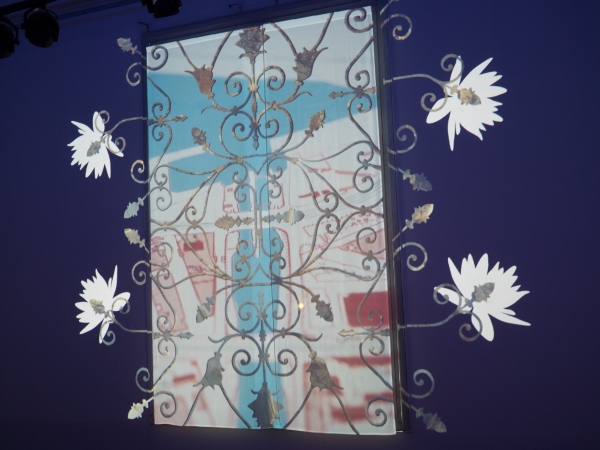
The incubator included a series of creative technology workshops exploring technology such as video projection mapping, microscopy, audio/video recording, and editing. We also explored project development and prototyping processes while sharing each others' experiences and vocabularies.
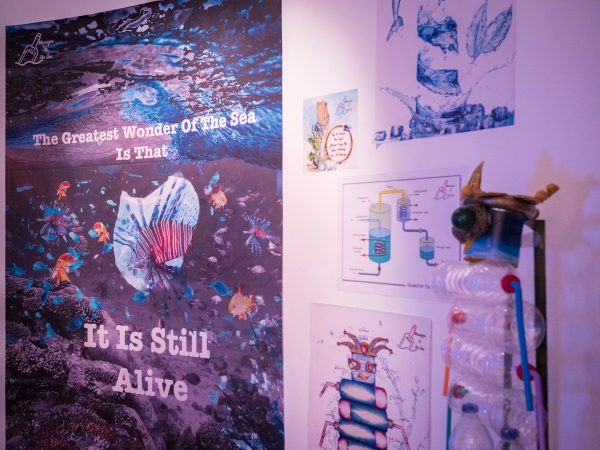
Our theme was water, with its myriad ways of connecting human beings to the environments that support us, while also being deeply affected by our actions. Through a variety of digital storytelling methods, we shared our stories of water and gained new knowledge and perspectives on the global scale of water-based environmental sustainability issues.
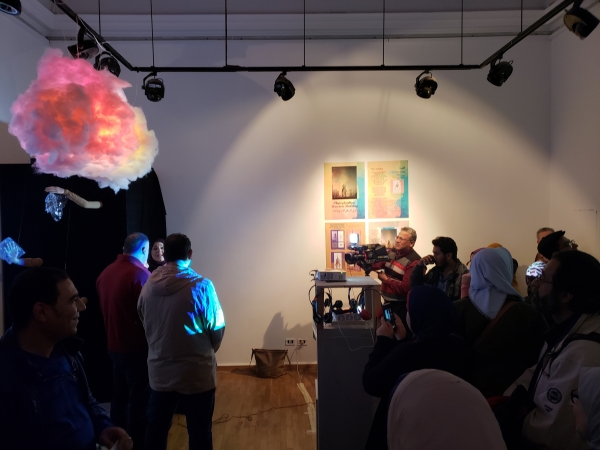
The American Arts Incubator – Poland “Layers of Life” workshop questioned “What is Life in the Bio-Tech Era?” through the lens of empowerment – exploring this pivotal point we are at in evolution across many strata, including personal, social, emotional and environmental impact, questioning how we can empower ourselves and our world, creating concepts and projects that provoke new ideas to shape a more resilient future.
Our inquiry resulted in presentations at a pitch event and an exhibition titled "Wystawa Warstwy życia" or "Layers of Life: What is Life in the Bio-Tech Era?" at Centrum Nauki Kopernik/ Copernicus Science Centre in Warsaw, Poland. It was a very inspiring month of growth and development working together. The work was exceptional, and the amount of development and accomplishment in this short period of time was nothing less than astounding. I felt proud of the participants and proud to be involved.
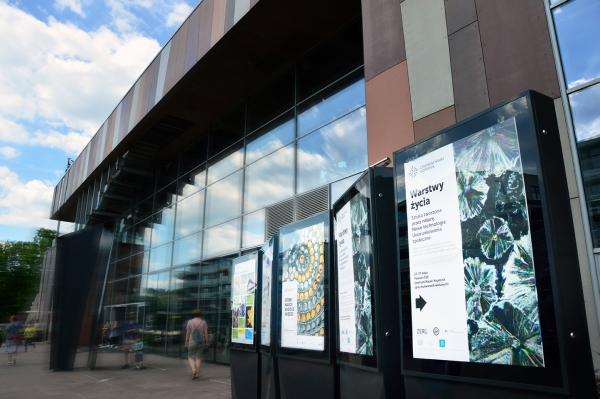
Posters outside of Copernicus Science Centre announcing “Layers of Life” Exhibition. Photo by Amy Karle.
The opening night was May 11, 2018. The evening kicked off with presentations from each group, who presented their projects and competed for funding to continue the work before a 200+ member audience and esteemed panelists: Aleksandra Hirszfeld — philosopher, artist, curator, writer/journalist; Joanna Jeśman — Culture Expert, Professor, Researcher; Wiktor Gajewski — Director of Copernicus Science Centre, Dan Hastings — Cultural Attaché, US Embassy Warsaw; and Amy Karle — Bioartist, Artist in Residence at Copernicus Science Centre, American Arts Incubator Exchange Artist, and teacher/faciliator for American Arts Incubator — Poland “Layers of Life” workshop class.
The pitches and projects were impressive and well-conceived in their creation and presentation. The judges asked poignant questions and gave great feedback! In the end, we determined all of the projects were so strong that the sustainability award funding would be divided equally amongst all groups so that they could all continue to pursue their great work. Thank you to our panelists for intriguing questions and thoughtful feedback, and thank you to the participants for your thoughtful and inspiring work!
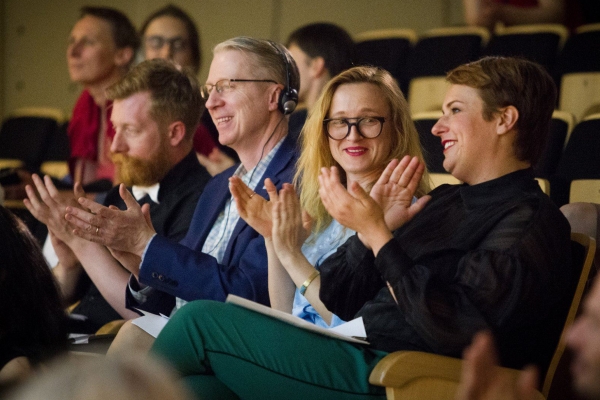
The opening of the exhibition “Layers of Life: What is Life in the Bio-Tech Era” at the Copernicus Center Pavilion overlooking the Vistula River was a celebration of the learnings, advancements, and achievement, and shared the projects which were a collection of art installations and bio-art projects in the fields of science, technology, engineering, arts and math (STEAM). The show and the event was a huge success! Over 500 attendees visited the exhibition throughout the evening.
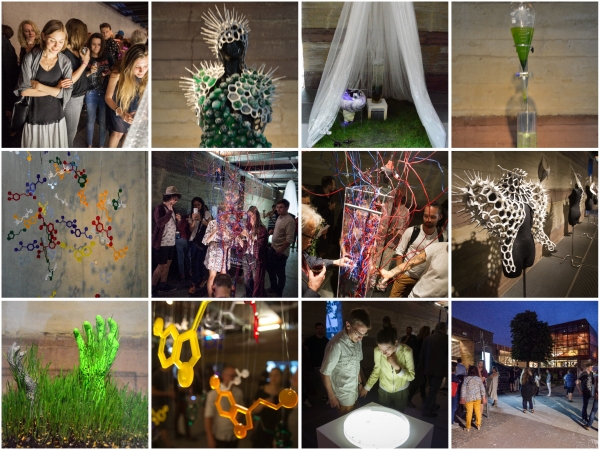
At the end of the night, The "Heavens of Copernicus" Planetarium at Copernicus Science Center hosted a special screening of a film by Artist Amy Karle recorded primarily from her work in the salt mines in southern Poland and under the microscope in the biolab at Copernicus.
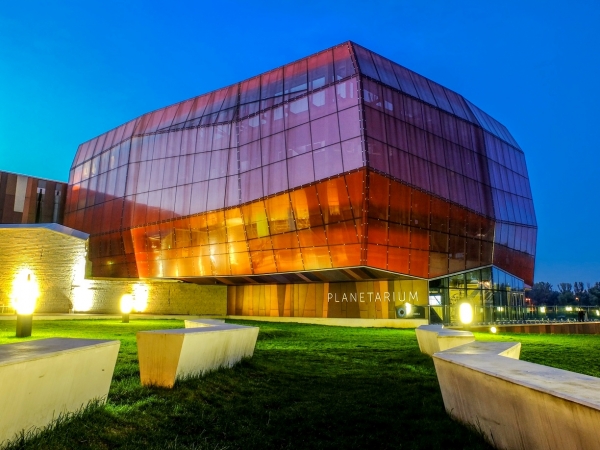
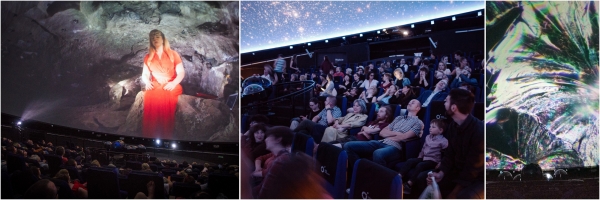
The point we are at in evolution is biology and technology merging. This can be destructive or empowering depending on how we use it. I explore how nature creates and how to use this mergence with technology to our benefit: to heal, enhance and empower us. My larger project as an artist studies what it means to be human. I use the body, art and design, science and exponential technology (including 3D printing, regenerative medicine / synthetic bio, AI, etc.) as mirrors to the self and mirrors to who we can become.
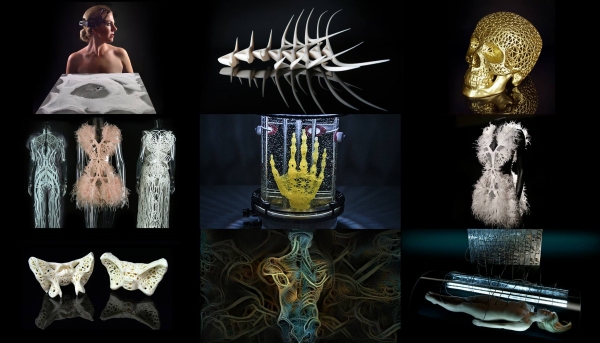
As American Arts Incubator Exchange Artist and Artist in Residence at Copernicus, I considered "Layers of Life" and how we form: biologically/socially/emotionally/spiritually — on all levels, while questioning, “What is life in the bio-tech era?” I wanted to transcend these layers — from the micro to the macro, from the individual to the social, from the internal to the external, from the depths of the earth to the sky, space, and beyond.
I conducted research in the labs at Copernicus Science Centre and in two UNESCO heritage sites: the Wieliczka and Bochnia Royal Salt Mines; in one of the deepest parts of the earth accessible to humans (in Bochnia), and studied concepts of space at Copernicus. I also researched how nature forms and grows: in this case, the natural additive manufacturing (natural 3D printing) of salt water/brine and crystallization. I considered salt as a vital, life-sustaining element in our bodies and of our earth, and learned about theories surrounding the origins of life, which astrobiologists propose may have began with salt.
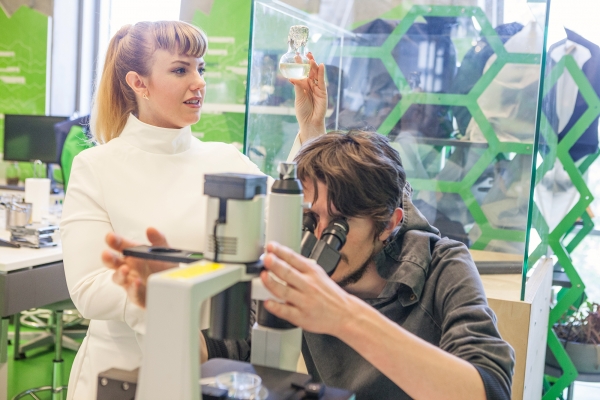
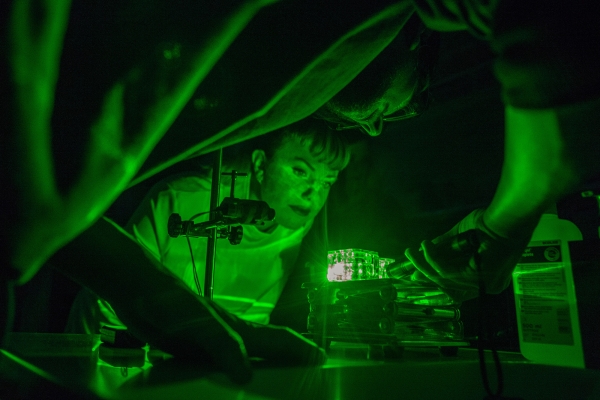
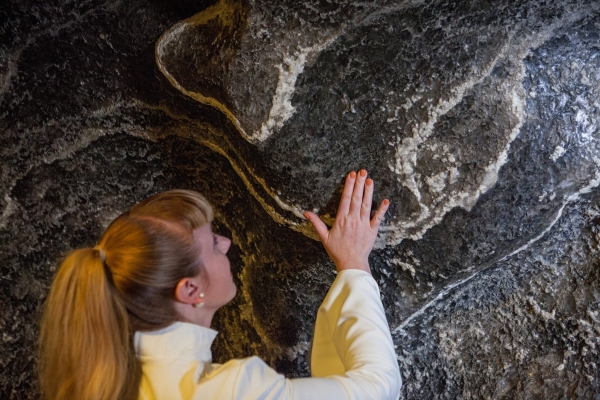
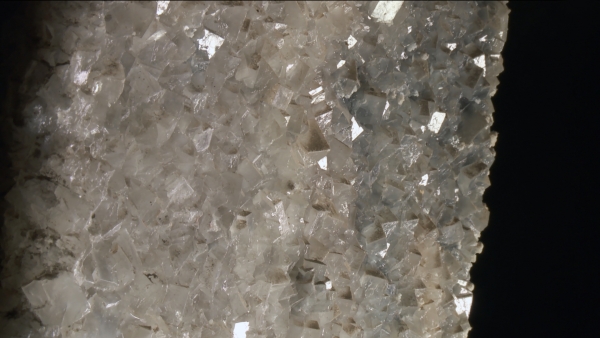
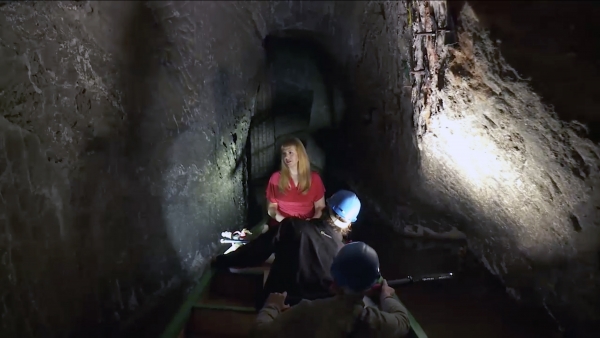
ARTISTIC RESEARCH in labs and mines conducted with the support of Copernicus Science Center Bio Lab, Stanisław Loboziak, Wieliczka and Bochnia Royal Salt Mines.
PRINTS Crystallization under various conditions under the microscope. Created in the Biolab at Copernicus Science Center with support from Stanisław Łoboziak:
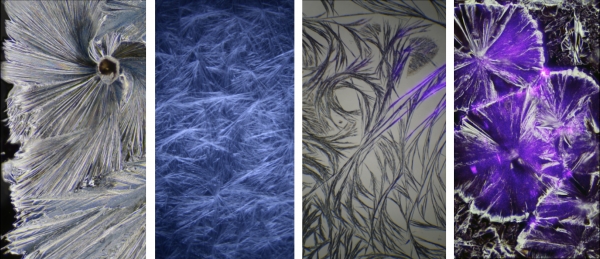
PERFORMANCE ART in Wieliczka Salt Mine. Film by Grain Films, software by Aaron Thomen, with support and sponsorship by Wieliczka Salt Mine.
SCULPTURE on the origins of life in salt and water. Considering the role of salts in our bodies, earth and universe; how nature forms and grows; and women's empowerment, these works are 3D printed sculptures with natural additive manufacturing crystal growth. “Crystal Copernicus” is a large scale sculpture made with generous sponsorship by Titanic Design and support from Benjamin Julian.
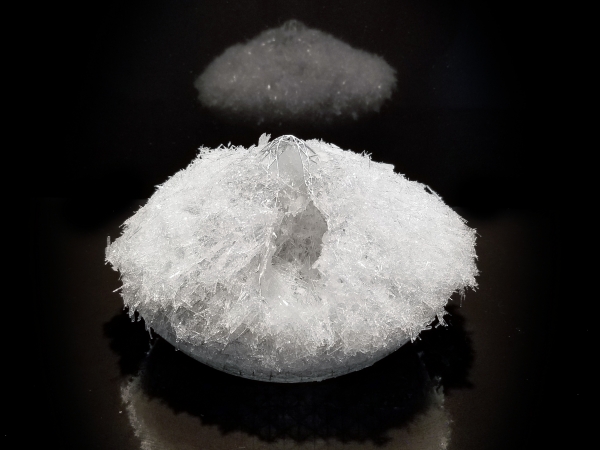
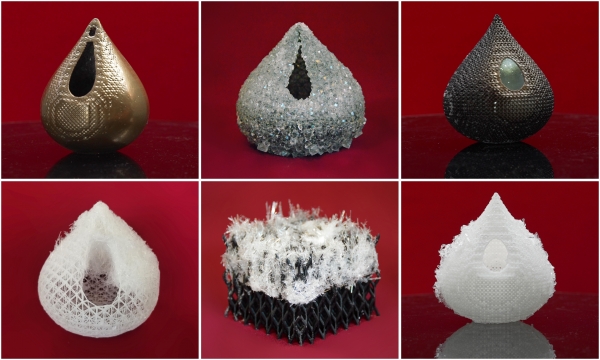
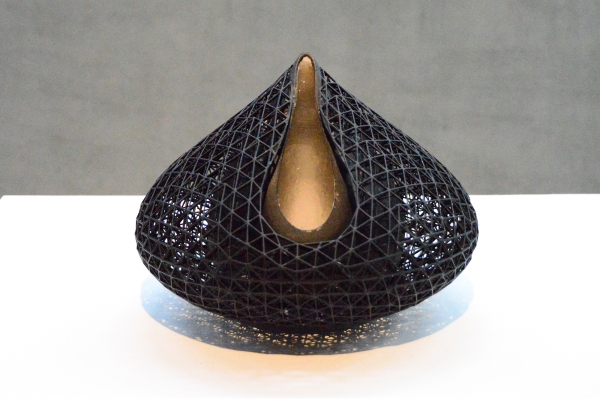
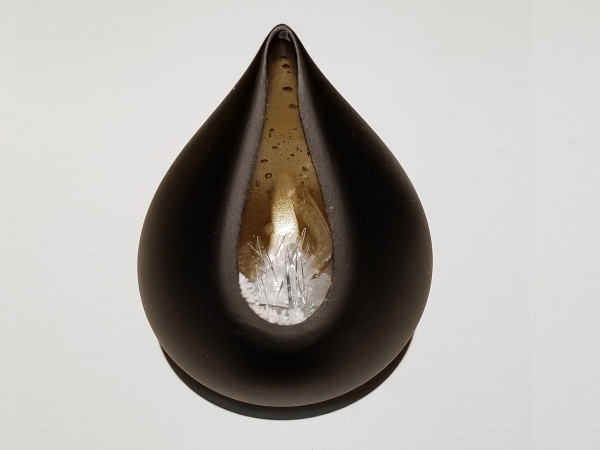
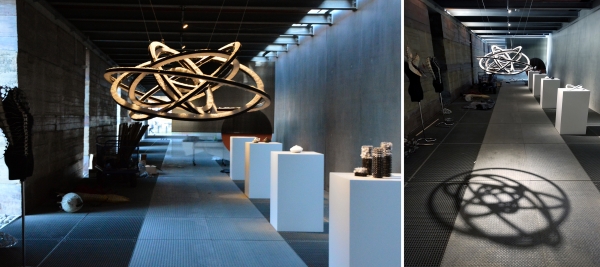
PLANETARIUM SHOW artistic video and sound art in Planetarium exhibition created with Grain Films (Maciej Przemysław Wróbel, Kacper Bartczak, Adam Woropiński, Piotr Wilhelmi), Copernicus Planetarium Team (Weronika Śliwa, Mateusz Borkowicz, Paulina Majda) and Copernicus Bio Lab / Stanisław Loboziak.

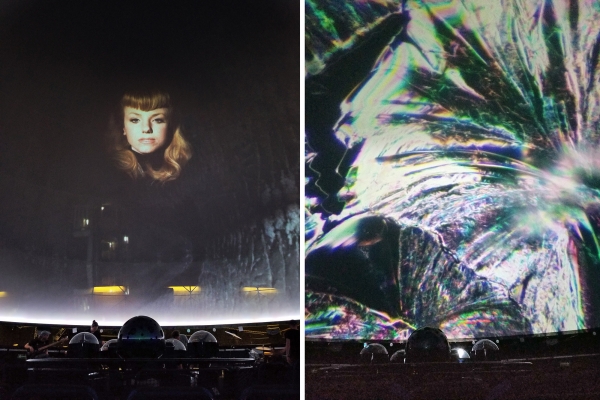
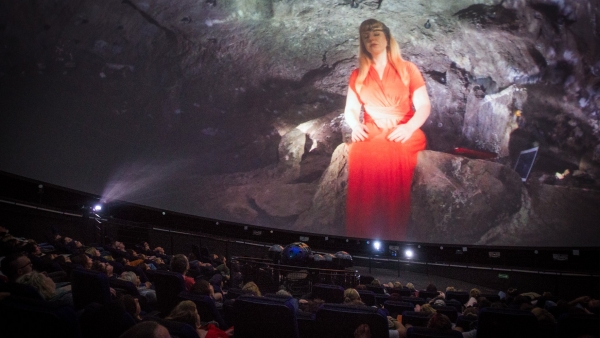 Film and Photos by Amy Karle, Grain Films at Centrum Nauki Kopernik.
Film and Photos by Amy Karle, Grain Films at Centrum Nauki Kopernik.See more images of Amy Karle’s artwork made while American Arts Incubator Exchange artist in the Facebook album Amy Karle's Artwork and on her website, Instagram, Facebook, and Twitter.
A very special thank you to: Bureau of Educational and Cultural Affairs — U.S. Department of State's , ZERO1, U.S. Embassy in Warsaw, Centrum Nauki Kopernik, Kopalnia Soli "Wieliczka", Kopalnia Soli "Bochnia" Planetarium Niebo Kopernika, Titanic Design: Rapid 3D Printing, Grain Films, and all those without whose generous support this project would not be possible.
Aggregation of biological data extracted from our bodies is a fact. Our virtual identities are being turned into a resource. The body, which used to be the source of power/life/vitality, is being turned into a generator of data, which is then used in ways that we often find mysterious. Global corporations know us better than our partners, families, and friends — better than we know ourselves.
Is escapism the only alternative to being a passive data provider? Can this situation be seen not only as a threat but also an opportunity? Can our interference with the digital data collection systems create a new space for social change?
Empowerment does not happen in the process of alienation but consolidation. Together we become strong. We believe in collective intelligence and cooperation between humans and technology. The installation “Pulse Translator” proposes a tool that transforms biological data and uses them to generate a new message.
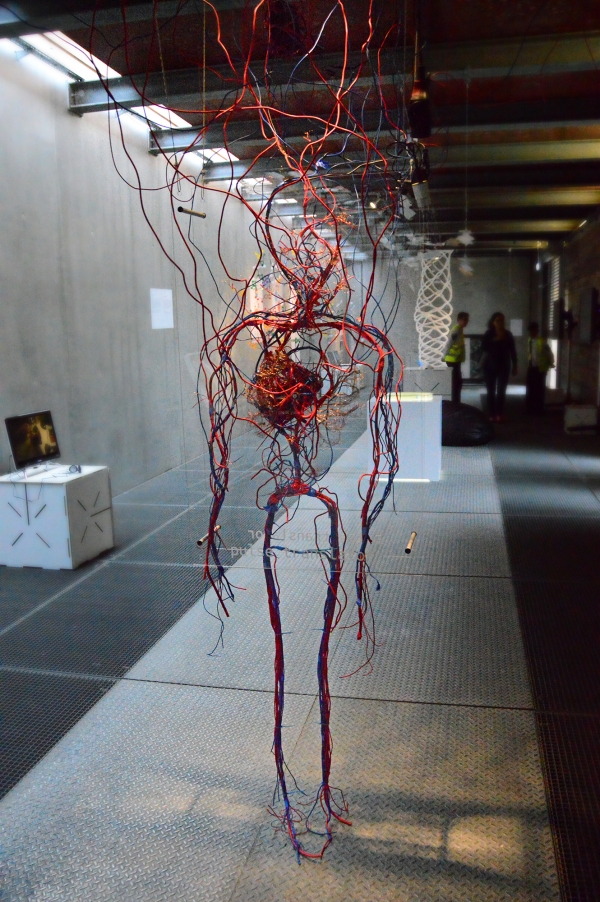
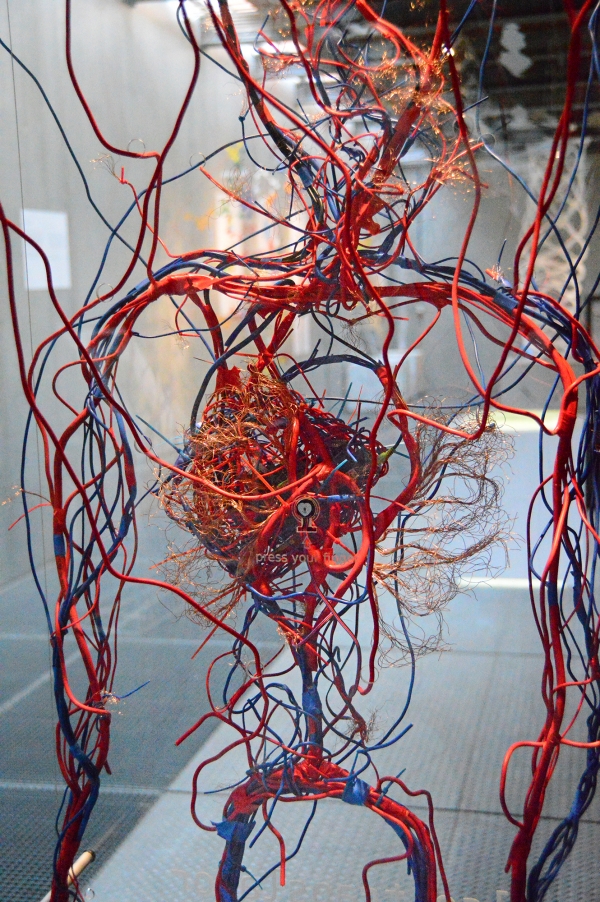
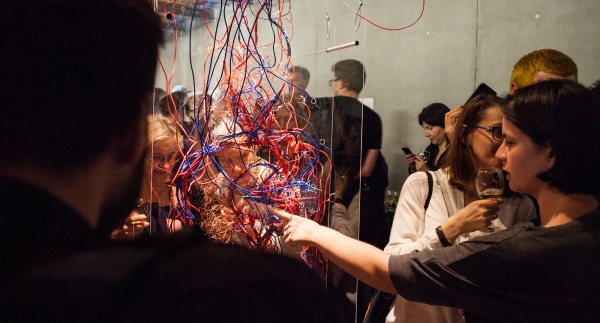 Pulse Translator, 2018. Photo by Grain Films.
Pulse Translator, 2018. Photo by Grain Films.PULSE TRANSLATOR collaborators would like to give special thanks to: Copernicus Science Centre, AAI, Amy Karle, Piotr Gołąbek, Piotr Pobłocki, Dagmara Kiradze, Mateusz Pawełczuk, Jacek Rosiński, Monika Urbaniak, and Kinga Szymańska. Created in cooperation with FabLab powered by Orange.
The Breath of Life is a prototype of a chamber with an oxygen reactor that intensively produces oxygen by water plants. The lung cleansing ritual is based on aquatic plants: cabbage and Canadian urea, which, thanks to their ability to carry out an intensive photosynthesis process, provide continuous oxygen production.
The project is a response to the growing problem of air pollution and everyday stress. We live fast on a day-to-day basis and do not think about processes such as photosynthesis carried out by plants to obtain oxygen which is essential for our lives. We are building roads, factories and many others structures, leading to the destruction of more and more plant species, resulting in the development of many civilizational diseases.
The chamber allows us to perceive with the naked eye this invisible-essential life function thanks to the oxygen bubbles produced by plants. The project shows in a physical way the process of photosynthesis and how important their preservation is to our survival.
Additionally, the chamber is a place where you can calm down and regenerate your lungs using conscious breathing. The high oxygen content has a positive effect on brain activity, which is the added value of the project. This experience is accompanied by breathing instructions to optimize body oxygenation and relaxation. Why is this so important? Because for most people stress is a factor that blocks them from developing their competencies. We can control this by breathing!
Breath is a powerful tool to regulate our mind and emotions. To enhance the experience, we’ve created a light and sound structure on the head to visualize the rhythm of breathing (by changing the color of the lights in coordination with the inhale and the exhale) with a mask through which air is taken in during breathing, saturated with oxygen from the reactor. Vases with water plants are live bioreactors that can filter air on the industrial scale and convert carbon dioxide into oxygen.
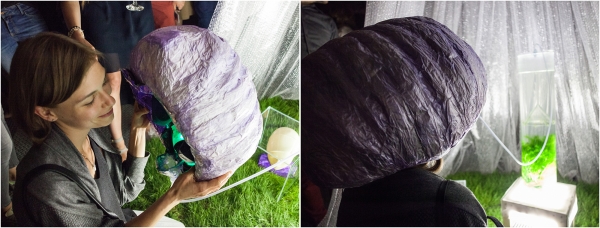
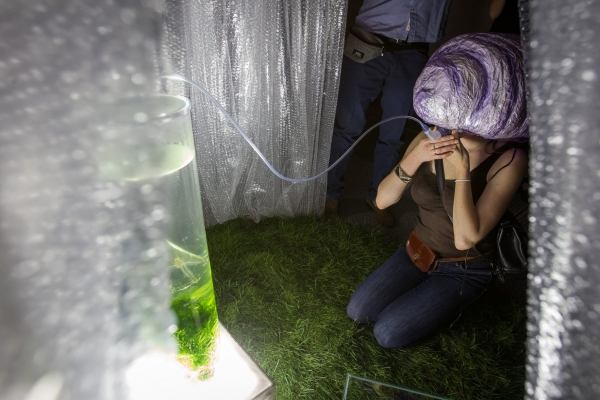 Breath of Life installation. Photo by Centrum Nauki Kopernik.
Breath of Life installation. Photo by Centrum Nauki Kopernik.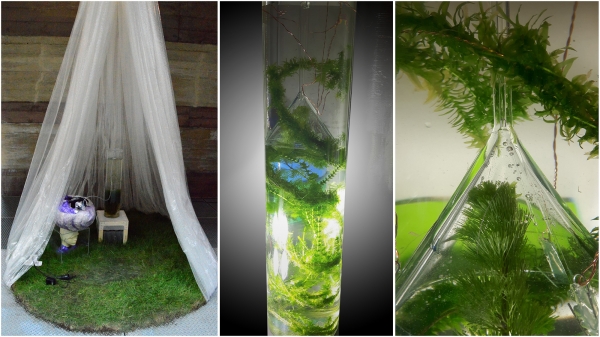 Breath of Life, 2018. Overview of installation and details. Photos by Amy Karle and Breath of Life.
Breath of Life, 2018. Overview of installation and details. Photos by Amy Karle and Breath of Life.
BREATH OF LIFE collaborators would like to give special thanks to: Copernicus Science Centre, AAI, Amy Karle, FabLab powered by Orange and Bartosz Andrzejczak.
Recent scientific discoveries are turning our attention towards the ability of plants and animals to perform photosynthesis, a process which until recently been attributed only to the plant kingdom. In our project, we ask questions and speculate about the possibility of using this mechanism. We travel to the future where plant-based tissue garments with chloroplasts and printable chloroplast tattoos can give us an extra shot of energy. The costume is accompanied by an installation showing the process of immobilizing algae Scenedesmus obliquus and closing them in alginate spheres. We were inspired by symbiotic relationships between plants and animals.
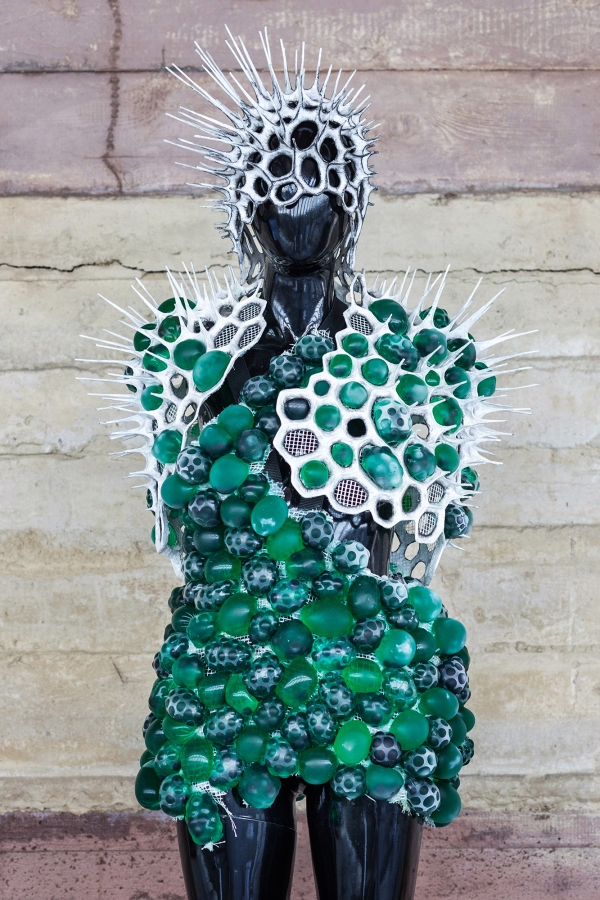
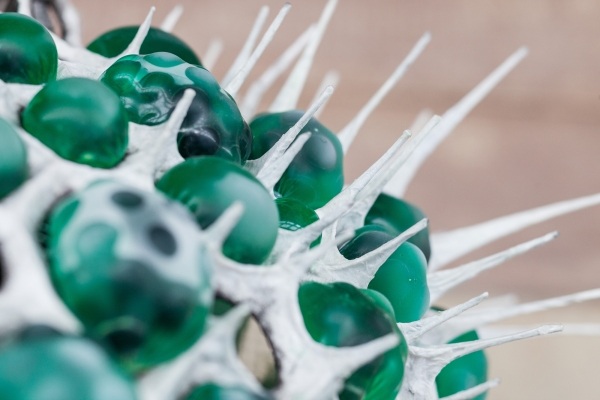 Chlorobody garment by Nika Danielska and Pola Demianiuk. Photo by Grain Films / Kacper Bartczak.
Chlorobody garment by Nika Danielska and Pola Demianiuk. Photo by Grain Films / Kacper Bartczak.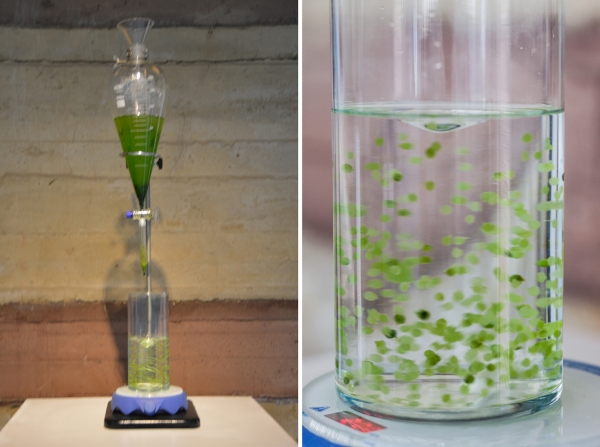 Immobilizing Scenedesmus obliquus algae in alginate spheres by Stanisław Łoboziak. Photo by Grain Films.
Immobilizing Scenedesmus obliquus algae in alginate spheres by Stanisław Łoboziak. Photo by Grain Films."The Breath of Life", "Oddech życia" by Agi Sadurska. Film accompanying Chlorobody / Plantenstein and sister project Breath of Life.
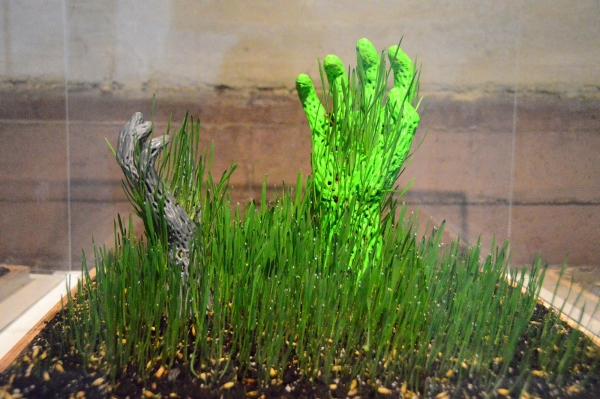 Plantenstein by Karolina Sulich. Photo by Amy Karle.
Plantenstein by Karolina Sulich. Photo by Amy Karle.CHLOROBODY / PLANTENSTEIN collaborators would like to give special thanks to: Copernicus Science Center, AAI, Amy Karle, Piotr Gołąbek i Piotr Pobłocki from Fab Lab powered by Orange.
We are currently able to culture only 1% of our microbiome in laboratory conditions. It is 2 kg of our body weight and affects our health and well-being. We were inspired to build a Petri dish that is 60 times bigger than the standard size, where we gathered microorganisms living on our workshop group cell phones.
Here, we can observe their mutual interactions, which also take place when we shake each others hands, kiss another person, or move through the world. It is a visualization of the world that is not accessible to us because we can not perceive it with the naked eye. Moreover, we usually relate bacteria to being sick, whereas only a small fraction of them are pathogenic. Most of them collaborate with us, protect our organisms, and drive life on our planet. Our microbiome is our unique biological imprint.
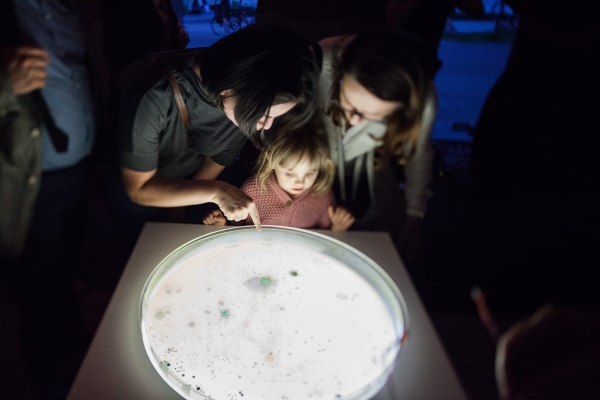
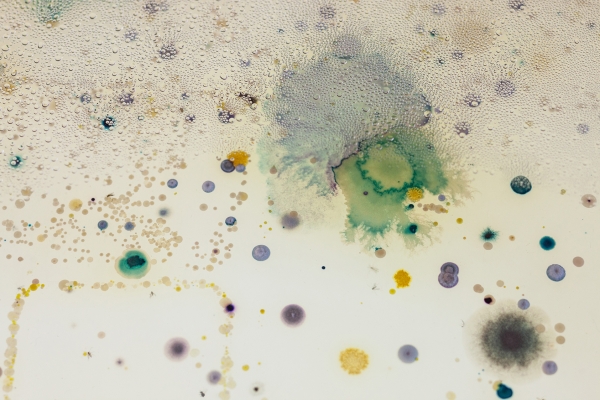
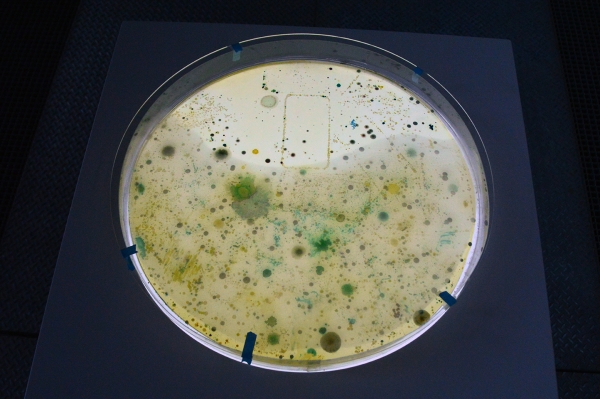 P.D., 2018. Photos by Grain Films and Amy Karle.
P.D., 2018. Photos by Grain Films and Amy Karle.P.D. would like to give special thanks to: Copernicus Science Center, AAI, Amy Karle, Piotr Gołąbek i Piotr Pobłocki from Fab lab, Kuba Stańczyk from “Dobry Plan," and company Plexipol.
How does our mind process emotions and how does our body use them? Could visualizing our emotional processes make it easier for people to express their feelings and understand the feelings of other people? How would our body and our society work if knowledge of emotions was more common? Would we be healthier if we knew how positive emotions are formed?
We want to show the unnoticeable, a layer that connects all the people in the world, and help them create beautiful and wise things. We want our recipients to see, hear, and experience by themselves the way emotions work, what they are used for, and how to use them. We want to encourage scientists to study emotions.
Our goal is to create the Pavilion of Emotions, a place that will fill our educational gap and help us gain knowledge around emotions, making it easier for us to make good and wise choices. The Pavilion will be a place of education, inspiration, and stimulation of our imaginations, where people will be invited to explore how important emotions are in our lives. At the exhibition, you will see a model of the Pavilion that symbolizes the mission of our project.
We used the model of Paul Ekman, which describes the six basic emotions that account for all the richness in our emotional lives. Our project’s main characters are Sorrow, Anger, Fear, Disgust, Enjoyment, and Surprise.
We have created an artistic visualization of sound waves accompanying words that describe our feelings and molecules of chemical compounds that co-create emotional states in our brain: dopamine — whose deficiency causes sadness, adrenaline — released by anger, noradrenaline — a fear-related compound, histamine — related to disgust, serotonin — a neurotransmitter associated with joy, and acetylcholine — which triggers surprise.
We have also designed a new Molecule of Empowerment. Who knows, maybe soon it will turn out that there is a molecule in our bodies that brings out the best in us?
The project also features a Dictionary of Indeterminate States – an educational game that encourages people to reflect on how the expression of feelings is culture-related.
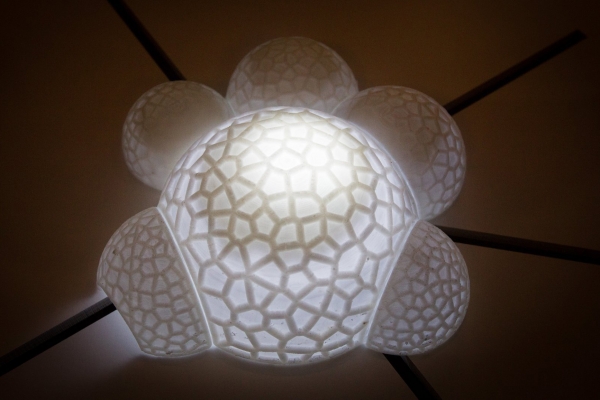
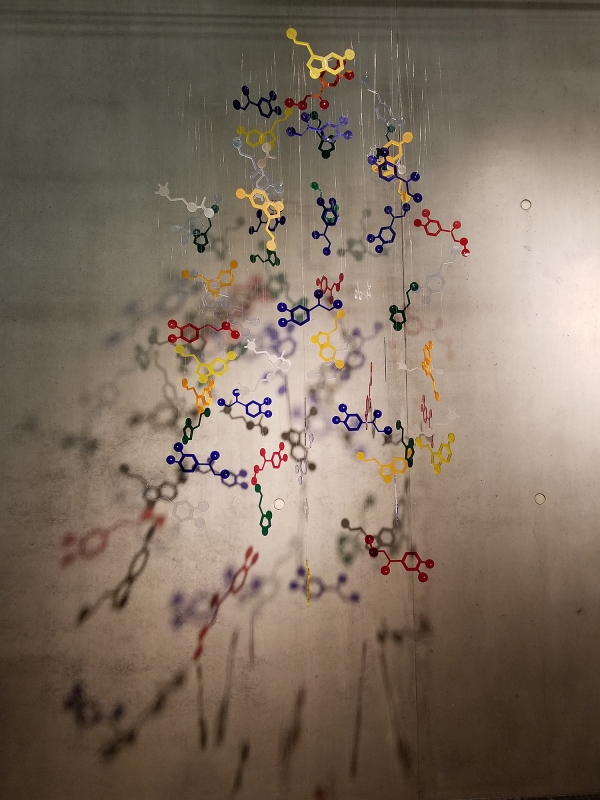
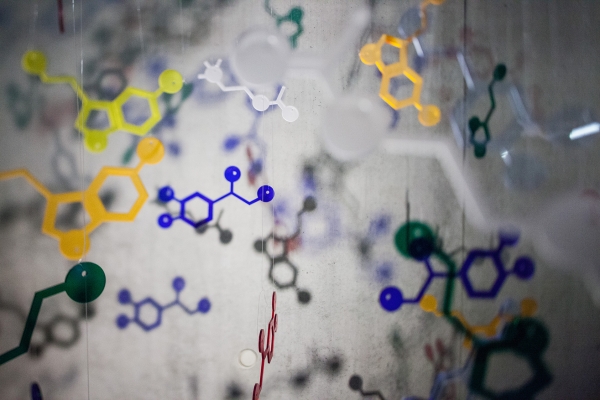 Installation representing molecules. Photos by Amy Karle and Grain Films.
Installation representing molecules. Photos by Amy Karle and Grain Films.Follow and learn more about LAYERS OF EMOTIONS at www.facebook.com/layersofemotions or www.facebook.com/niedookreslone
LAYERS OF EMOTIONS was created in cooperation with FabLab powered by Orange with special thanks to: Copernicus Science Center, AAI, Amy Karle.
Inwertomin is a visual representation of air monitoring stations. It encourages you to stop, breathe in fresh, pleasantly cold, and clean air, and to reflect on the problem of air pollution in the city.
Inwertomin is based on the concept of a reversion of the traditional chimney. Instead of spitting out hot fumes, it absorbs polluted air from above and releases it cleaned through the bottom side. The device's functional base is a cooling and moisturizing installation which moves the air inside downwards. One of the solutions we considered in order to achieve this effect is using a cooling substance in Inwertomin's external layer. Inwertomin's core consists of air filters inspired by coral reefs and moss. Their structure enables airflow within large surfaces. The pollution gathering on the filters causes Inwertomin to change its color from white to brownish-grey. The Inwertomin transforms itself gradually according to the airflow — it becomes dirty at the top and remains clean at the bottom. It acts as a warning totem visualizing the degree of air pollution.
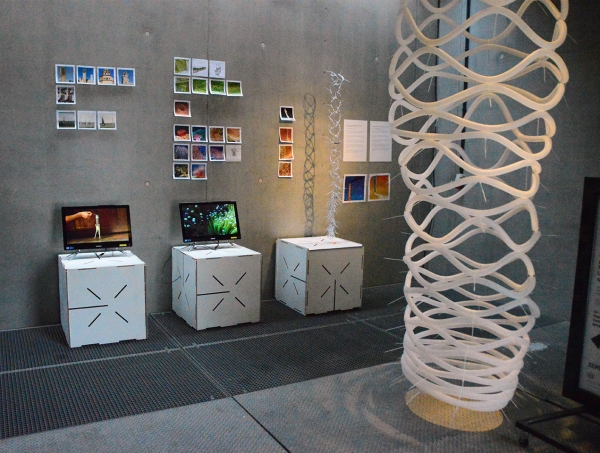 Inwertomin installation at "Layers of Life" Exhibition. Photo by Amy Karle.
Inwertomin installation at "Layers of Life" Exhibition. Photo by Amy Karle.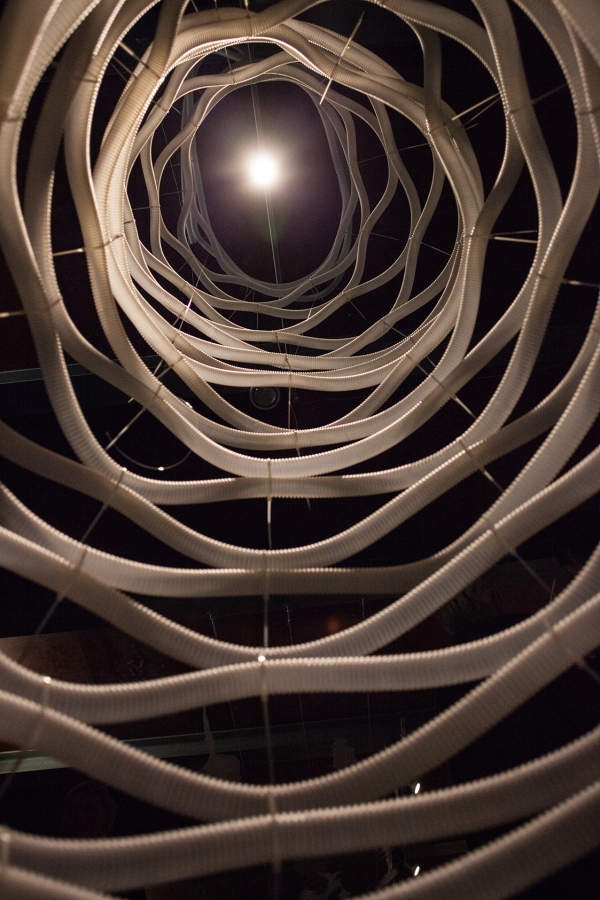 Inwertomin, 2018. Photo by Grain Films.
Inwertomin, 2018. Photo by Grain Films.*Descriptions on the projects above were provided by each team.
These projects were produced as part of American Arts Incubator, an initiative of the U.S. Department of State's Bureau of Educational and Cultural Affairs and is administered by ZERO1. The incubator in Poland was produced in collaboration with U.S. Embassy Warsaw and the Copernicus Science Centre.
As an American Arts Incubator exchange artist, Artist Amy Karle’s task was to focus on public diplomacy and social innovation to empower women in STEAM in Warsaw, Poland. She led workshops and field trips, taught new media art skills, encouraged collaboration, and facilitated and supported teams to create community projects using art and technology to address social challenges in the model of a hybrid artist residency and Silicon Valley type incubator. The workshop concluded with the presentations, a panel review, small grants funding, and the public exhibition discussed above.
Follow the conversation, get updates and inspiration at American Arts Incubator — Poland Facebook group at: https://www.facebook.com/groups/361402877645612/
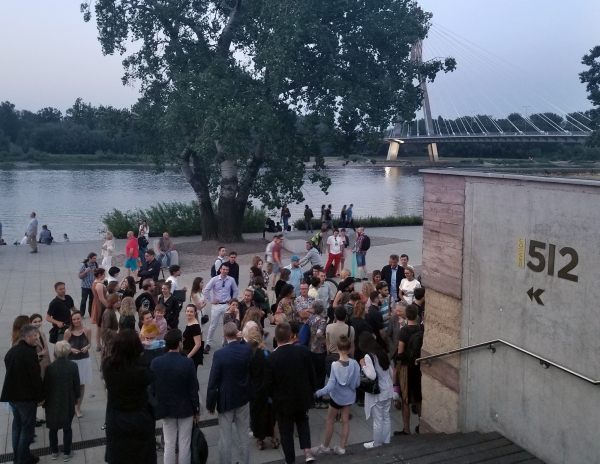
I am so proud, again, of all the participants as individuals and as teams. There are a few other notable teams that were crucial in realizing these project work: ZERO1, L’Uzine, and the American Consulate in Casablanca.
I want to thank them for their help in supporting the program from start to finish and for inspiring the project that I am currently wrapping up as part of my exchange. This was a team effort.
---
In particular, the energy and excitement of L'Uzine have been my muses for this project.
The same line repeats in every iteration of the project proposal leading up to my departure to Morocco, “My personal project will be an architectural scaffolding for the participant projects…” Familiar neither with the organization nor with the participants, I imagined I would build a structure or design a space that could host each of the participant project prototypes.
But over the course of the workshops and as the participant projects developed, I realized that this scaffolding already existed; every day, the flurry of events and excitement, the rhythms of dance and meditative motions of textile design, the focus of the camera lens, the reverberations and translations of music, the flittering of fabrics, the echoes of philosophical conversations, and the fun that moved across, up and down, and around the building of L’Uzine.
Raucous laughter and decisive actions emanate from the 1.5th-floor administrative offices. Delicious smells waft up the stairs from the kitchen where Fantom and Fatima prepare a meal for the staff and visitors to eat together, pausing between energetic spurts of technical management, deconstruction, shopping, posting, meetings, and, of course, answering seemingly incessant questions from guest program coordinators, like me.
Zineb Haddaji’s responsive, positive, and witty perspective kept the program and the projects moving within and beyond office hours. Maria Daif’s infectious enthusiasm gave context to the projects. The care with which Nadir Houboub considered each shot, sequence, and composition and the poetry of each image by Ahlam Maroon represented our program so eloquently. Hamza Lyoubi's even and careful timing and articulation, and Abdessamad Bourhim’s intense and speedy technical execution bolstered our work. The workshops and exhibits also would not have been the same without Dounia Jawhar's calming presence, Sabrine Hakim's insightful questions, Abdessamad Noudirate's energy and resourcefulness, and Kristi Jones’s indispensable insight and support. And, last but not least, Fouad was always ready to open a door.
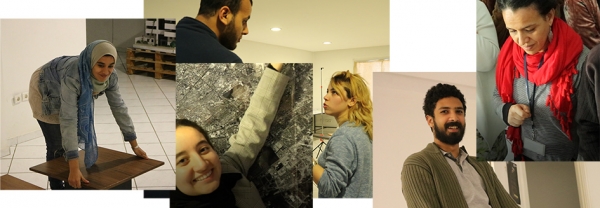
The concept for my project came from the recognition that L’Uzine — as a building and organization — is a scaffolding that can and does support not only prototypes but ongoing work on the critical questions and concerns expressed and explored by the participant projects. L’Uzine’s heart and muscle are already doing the inspiring work of community building, recognition, and representation. Its body is filled with diverse projects and programs that display, disclose, and question.
L’Uzine’s building is not only a center of culture, it is also a cultural puzzle. It is a place where mega-cultures, mass-cultures, and sub-cultures connect, coincide, collide, and fuse together. Its spaces are allocated to music, dance, theater, performance, photography, painting, and design, and its circulation spaces host encounters among artists. The cultural puzzle re-imagines the way the building is subdivided — grouping spaces to create variegated cultural portraits through a diversity of disciplines and sensory stimuli.
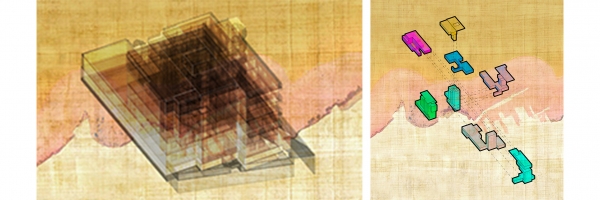
This is a curatorial concept:
Three puzzle pieces represent the heart and muscle — L'Uzine's staff — the Heart, the Arm, and the Spine.
Five puzzle pieces represent cultural exhibitions, inspired by the Rhetorical City participant projects: each one uses a collection of sensory spaces to immerse visitors in a sub-culture — each organ perceiving, processing, and interpreting different aspects of the exhibit.
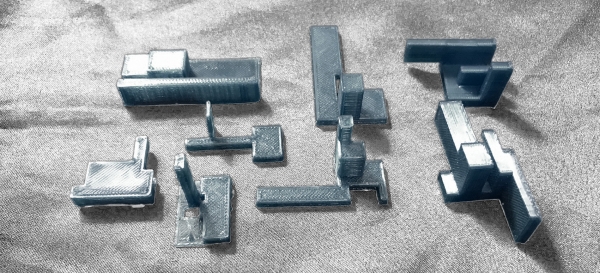
Meanwhile, the Cultural Canvas & Composites concepts are a fusion of the American Arts Incubator model and some of the incredible work that is already underway at L’Uzine.
AAI bolsters the growth of artists through the development of art projects addressing questions of community, technology, and entrepreneurship. Shamsher Virk and Maya Holm provided an incredible foundation, and go above and beyond in coordination to support this process. And the Department of State and American Consulate were so generous in their support of the program and participation in its exhibition event — especially Stephanie Jensby, Salma Benbouia, and the Consul General, Jennifer Rasamimanana.
Artists explore and grow at L’Uzine — some participate in workshops and projects for fun, some become employees of the organization, and some become recognized city-wide, nationally, and internationally for their craft.
The Cultural Canvas & Composites concepts underscore the role that L’Uzine already plays as an incubator by providing concepts for small and large, singular and serial, physical and digital interventions.
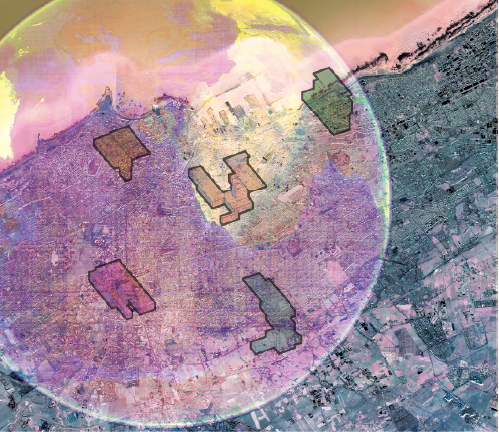
I want to return for a moment to the basis of this project — asking questions about empowerment through mapping and data collection and representation. Among the great concerns with power, data, and mapping are disempowerment, misrepresentation, and obfuscation, respectively. However, perhaps if we understand the systems by which these are constructed, we can become not only critics of but also activists within them, transforming the criticality that sometimes seems external to societal structures into something that is intrinsic and inherent to societal growth and development.
Perhaps social entrepreneurship is an exquisite product of opportunities for open self-expression and public conversations about convictions. And, finally, perhaps this constructive-criticism-turned-social-entrepreneurship is a form of love that can ultimately make a positive impact on our families, friends, neighbors, and communities.
---
I can't wait to see what forms the AAI participant projects take as they develop in the future and to see what configurations L'Uzine might take as it continues to do its incredible work
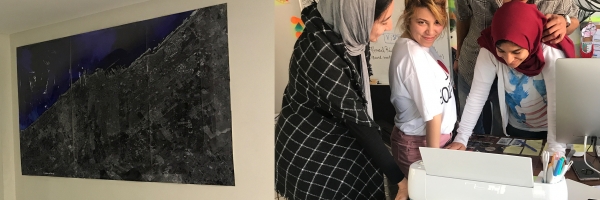
We are more than halfway into American Arts Incubator — Poland, and it has been an amazing journey witnessing our growth, development, and empowerment of participants and myself through the “Layers of Life” workshop.
Each exchange focuses on a social challenge unique to that country. The social challenge for my exchange focuses on women’s empowerment in STEAM. Before I went to Poland I started asking my family, friends, and colleagues what “empowerment” means to them. It is unique to everyone and a very interesting question to ask. I was impressed by the answers that I was given, it revealed so much about each person and opened my mind as well.
When I got to Poland, I started asking the same question — and quickly learned there is no word for “empowerment” in Polish. So, from the beginning of the workshop we consistently explored what “empowerment” means to each of us, and collectively, how we could explore and express it in theory, practice, our work and our everyday lives. We are still exploring this as we prepare our projects for the upcoming exhibition and pitch/panel review.
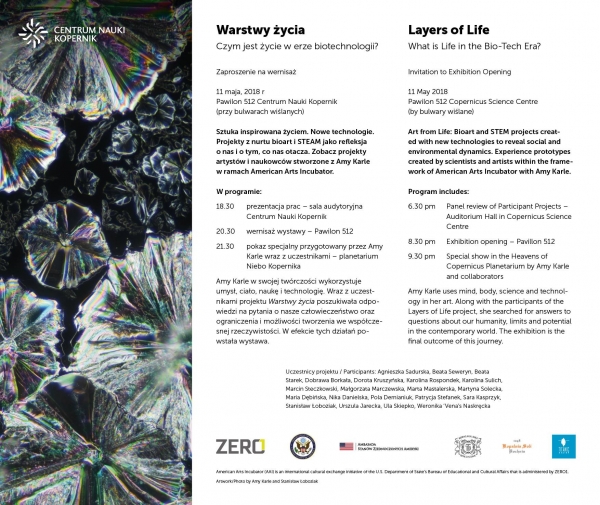
Once we brought the concept of empowerment into our awareness, it quickly became evident that considering empowerment — how we can be empowered, how we can empower others, how we can make a situation empowering, etc. — is a very powerful lens to look through and can bring about positive change very quickly.
We found the spirit of empowerment is from within and also in support from and for others to enable and empower each other. It's diverse, and unique to all of us.
From within, we have been finding new skills in ourselves as well as inner strengths to try new things with boldness and courage.
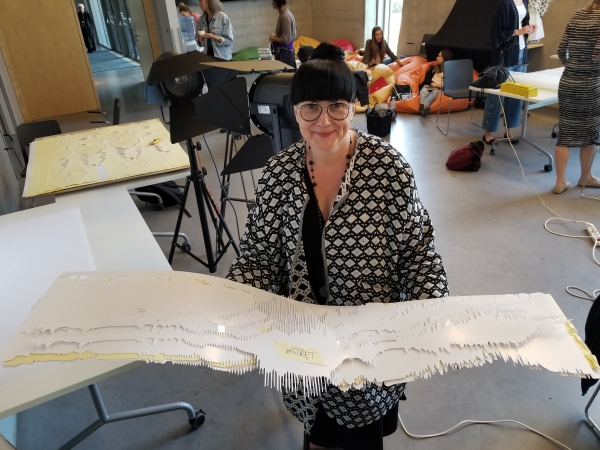
For many participants, it's the first time working with digital manufacturing and fabrication technologies, working in diverse groups (with artists, scientists, theorists), collaborating across disciplines to make projects, as well as presenting, pitching, and exhibiting.
For me too, this was my first time leading a workshop. From the very first day of leading this workshop, it became apparent that empowerment to me is creating the space for others to make their best work, and ultimately to be their best selves. Reflecting on my role in this workshop has taught me the value of this position from the very beginning and I have done my best to come from this place while facilitating participants and their projects to grow... and do my best to set a great example working alongside them.
As the work from the exhibition and panel review comes out, I hope you can see the astounding conceptual development, execution, scope, and refinement of what was produced in such a short period of time — and see the projects both as they are and all that they achieved within this short timeframe — as well as the potential of what these projects and this work can become.
This brings us to the other part of empowerment — support from others. We truly couldn’t have done what or as much as we have without the people who supported, collaborated with, and empowered us. Cooperation, collaboration, support, inspiration… I don’t know if I could name exactly what it was that brought us to grow and achieve so much in such a short period of time, but something that the people and institutions who supported us did, and something we have been doing for each other enabled us and empowered us to make a quantum leap in our work and feel good about ourselves in the process.
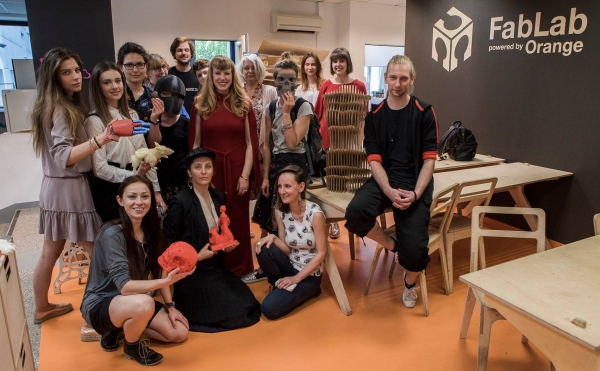
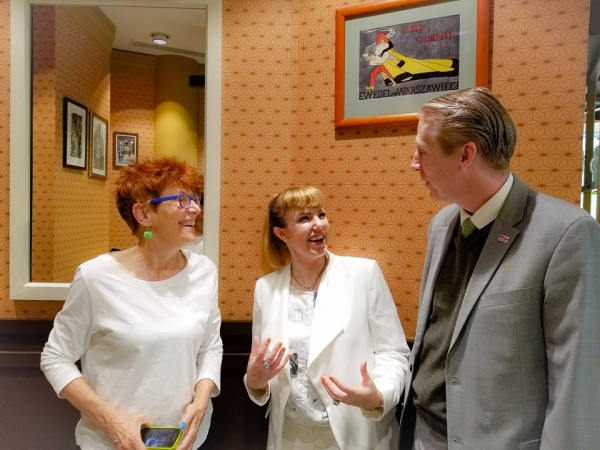
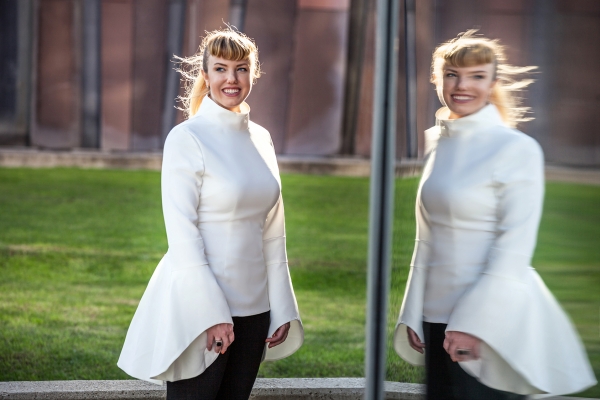
Learn more about our workshop and programming at:
It’s been an incredible month at IZOLYATSIA, and I can’t believe how far we’ve come! March 29th was the opening reception for Emergent Tributaries at IZONE, showcasing collaborative works from the community groups as well as myself. The name of the exhibition is in reference to the Dnipro River, which has historically played a central role in shaping the landscape and cities alongside it in Ukraine: as an ancient trade route for goods and supplies, a place for cultural exchange and gatherings, and a provider of energy through hydroelectricity.
I chose the Dnipro River as an entry point into this exhibition — as a meeting place of cultural exchange for a visiting artist and curator from America working at IZOLYATSIA, which is right on the riverbank. I also chose it metaphorically for its ecological network, which connects Ukraine through its many tributaries, as this exhibition has done the same for artists gathering from different parts of the country.
Now linked with digital technologies in a similarly networked fashion, Emergent Tributaries reimagines the present and future of Ukraine through the eyes of these artists and their collaborative new media works. Along the Dnipro riverbanks as well as in other physical and digital spaces, they have refigured cultural identity, personal identity, and our relationship to ecological systems, technologies, our bodies, and the spaces our bodies inhabit through speculative design and design fiction.
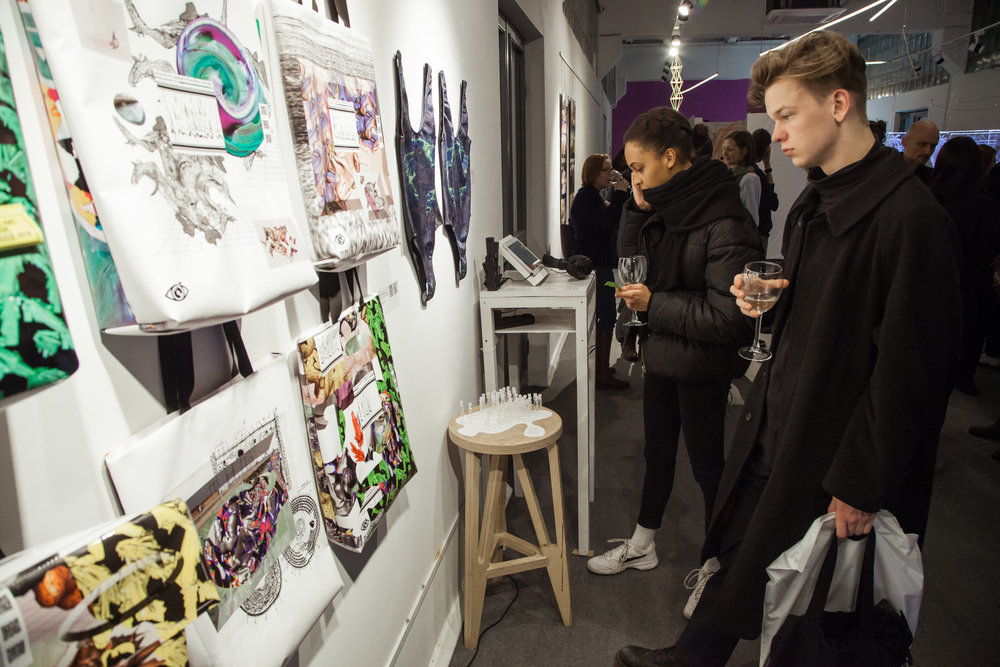
There were four main collaborative projects in the exhibition:
The Waters Come Into My Soul examines water pollution in Ukraine, particularly along the Dnipro River. The industrial run-off and overabundance of phosphorus, nitrogen, and phosphates causes active reproduction of cyanobacteria that spurs the "Dnipro blossoming" phenomenon, which negatively affects the flora and fauna of the river as well as the physical and psychological state of the people living nearby. The group investigated this phenomenon through digital textile prints, algorithmic video, projection, 3D prints, microscopy video, and sound.
The Waters group: Julia Beliaeva, Elena Klochko, Bogdan Moroz, Anna Prokopets (Umka Estebanovna), Iryna Proskurina, Alla Sorochan, Olga Tereshchenko, Oksana Chepelyk
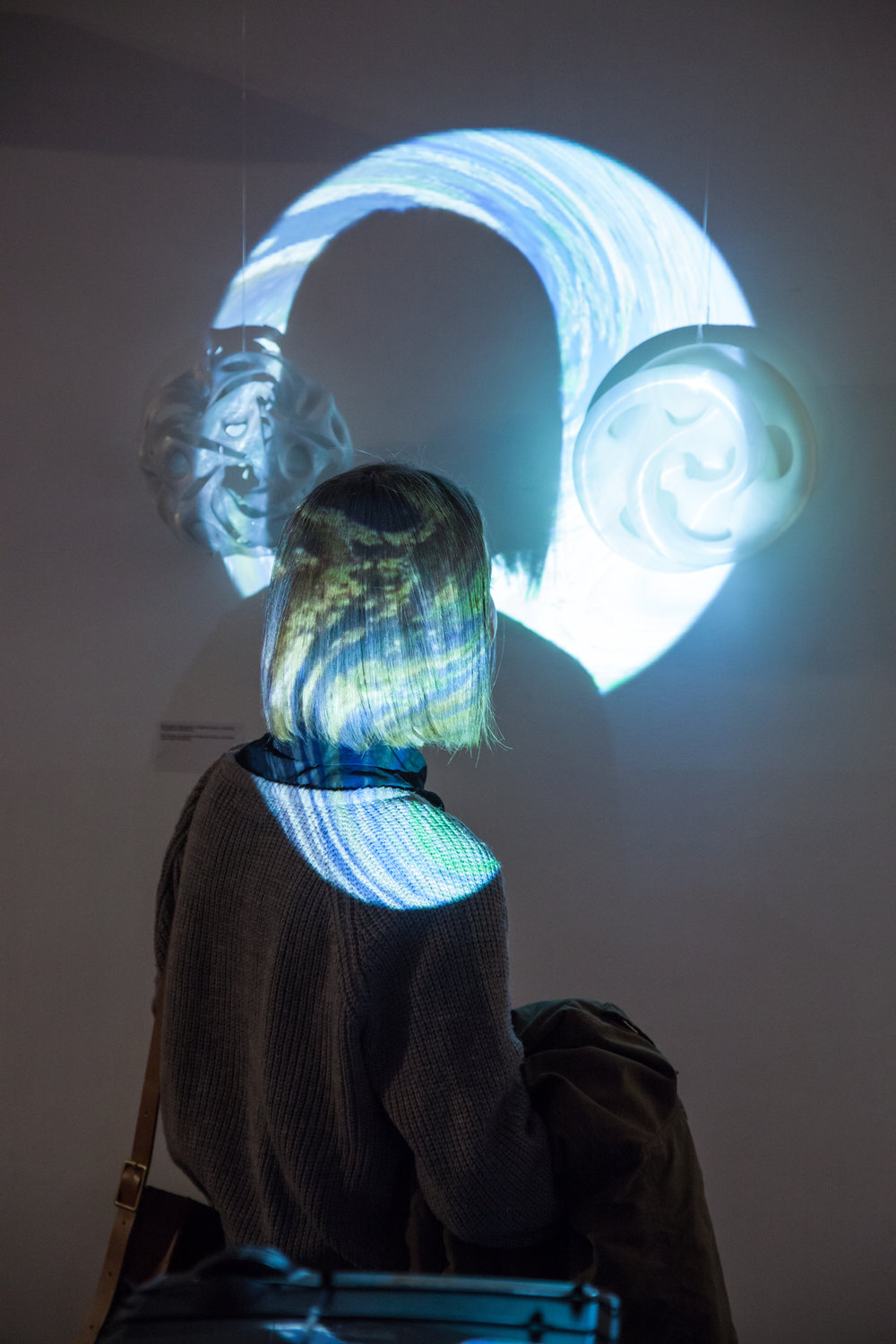
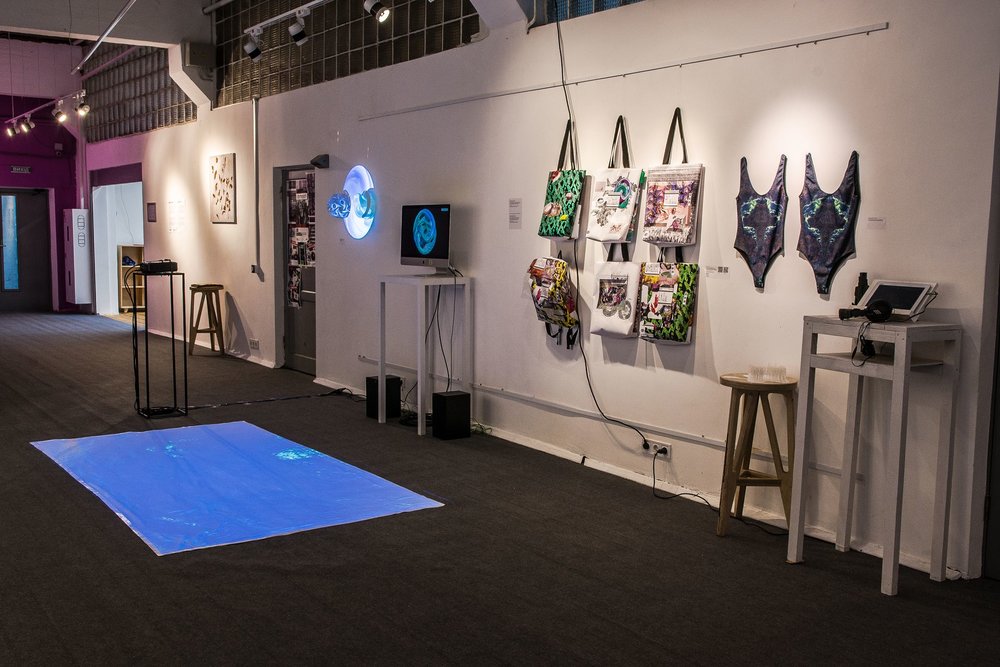
Island Ї is a speculative floating artificial island on the Dnipro River. It is an open university and a scientific laboratory — a platform for artistic and scientific projects. Island Ї is a rhizome of diverse ideas, styles, and decisions that represent the diversity of Ukrainian identity. It combines harmoniously what seems like an insoluble contradiction: an academy of sciences, an erotic education center, self-regulating sails, and architecture with biomimetic forms achieved through futuristic technology of adaptive and regenerative growth.
Island Ї moves freely along all the rivers of Ukraine, to all the cities and remote towns and villages, influencing people and changing society through forms of nonlinear and horizontal interaction.
Mincult group: Yurii Efranov, Elena Klochko, Yaroslav Kostenko, Anastasiia Loyko, Mykhailo Rozanov Kateryna Shyman, Krolikowski Art
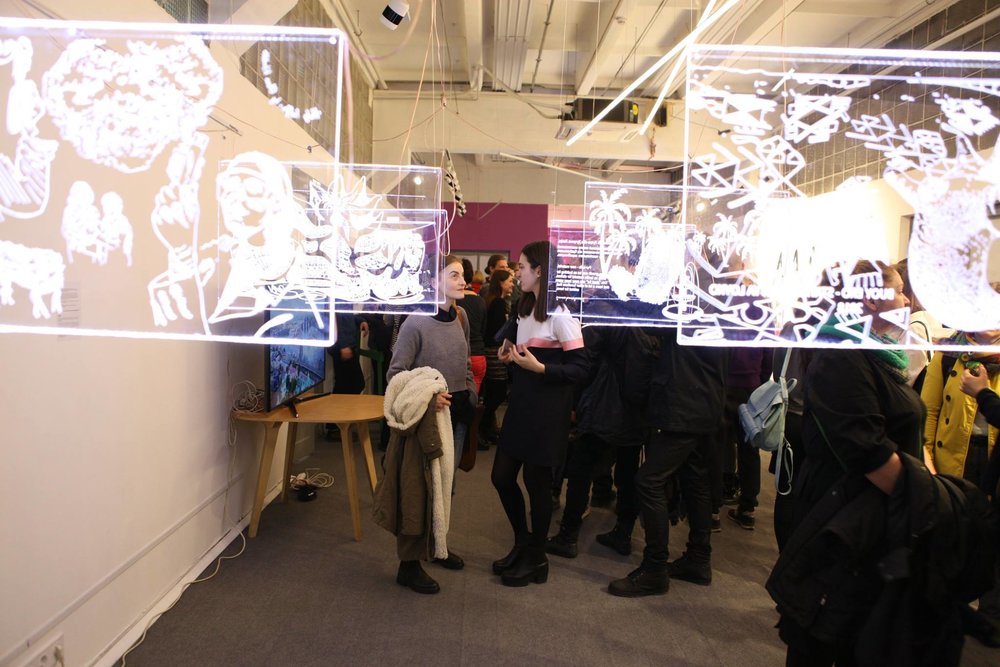
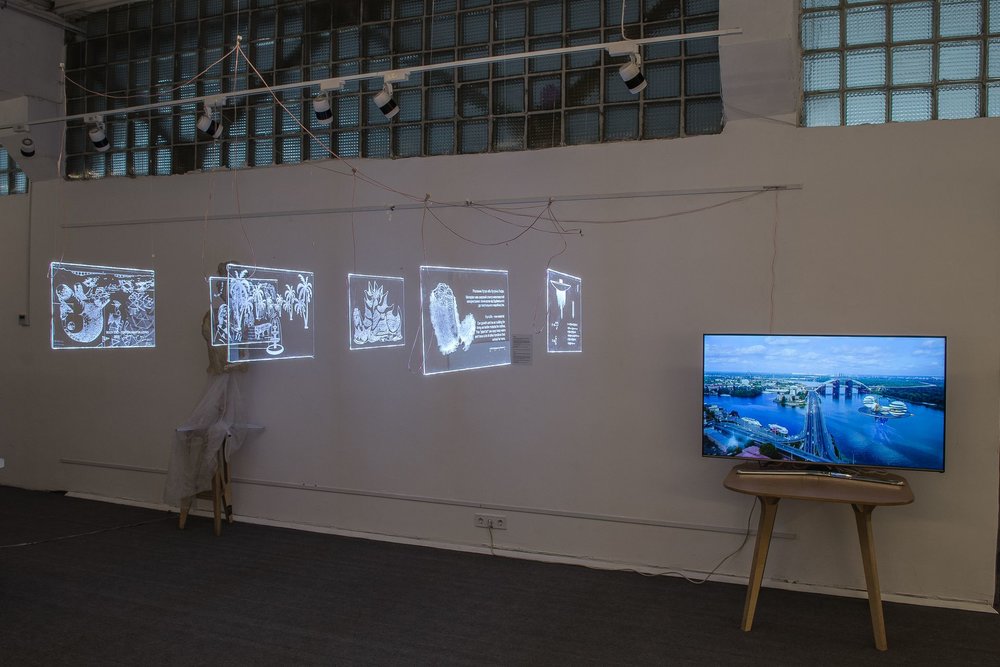
Session Room involves ASMR and Ukrainian identity, focusing on the lack of boundaries between public and private space. This project features a zoned, partially enclosed space in which the viewer can feel solitude and simultaneously experiment with various tactile and auditory elements including 3D video portraits of the artists and their voices.
MEDITATOR group: Alina Borysova, Anna Kakhiani, Anna Korniets, Irina Kostyshyna, Alyona Mamay, Oleksandr Manukyans, Hanna Shumskam, Oleksiy Yaloveha
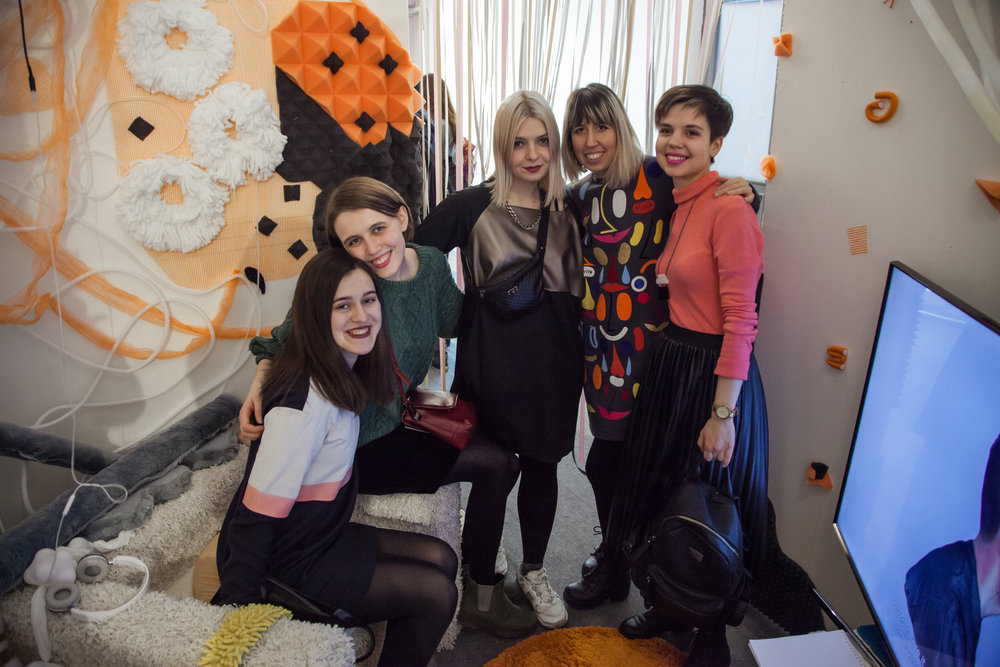
Spidertopia explores a theoretical renaissance of Ukrainian identity free from territorial invasions. Using the language of traditional “pavuk" or "spiders,” module-like elements of Ukrainian home decor which pre-dates Christianity, the project applies it to a utopian world. But within that high-tech world, we notice something strange… Spidertopia highlights a peculiar Ukrainian attitude on the verge of comedy, tragedy, and irony that has seemed to persist. It is an exercise in self-observation: times are changing, but do we change with them?
SPIDERTOPIA group: Ivanka Borodina, Olha Vashchevska, Serhii Nizhynskyi, Maria Proshkowska, Bogdan Seredyak, Olga Synyakevych
.jpg)
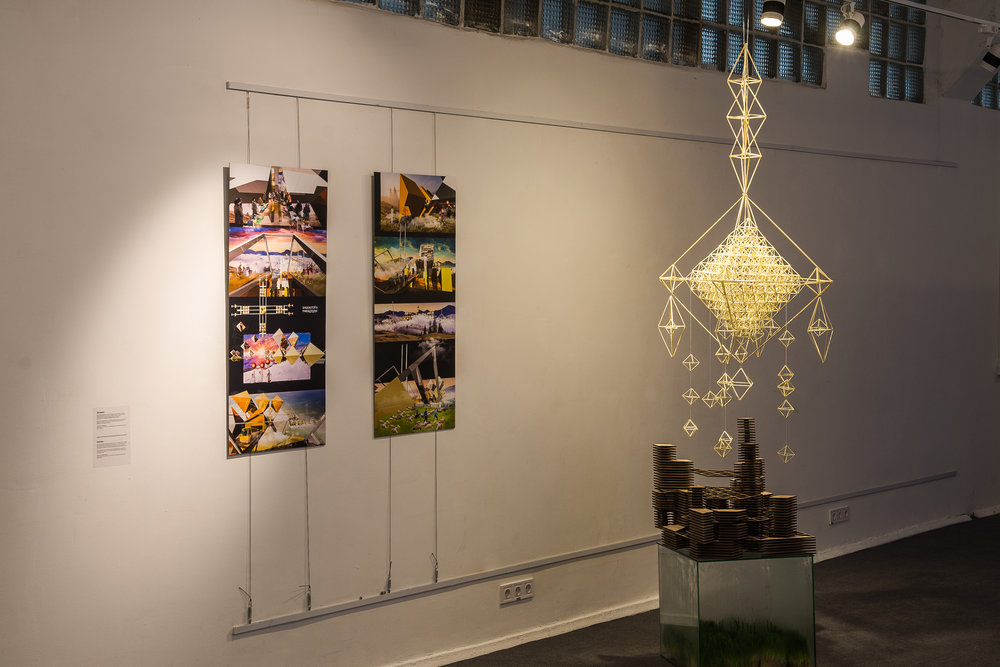
For my personal project, I focused on the “Dnipro Blossoming” phenomenon. I wanted to explore material transformation through the lens of the Dnipro, and created intimate portraits of the river in acrylic, transferring its boundaries to become a central focus to address this topic, layering and juxtaposing man-made tributaries with ancient and natural flows.
Using a water battery with polluted water from the Dnipro and speculative algal bioreactors, I consider converting cyanobacteria and polluted water in the Dnipro into energy; in this case, for illumination. A reframing of the river helps us to reconsider our impact on it and future methods of harmonious collaboration with it, other ecologies, and non-human species.
Another project I did in collaboration with participants and my partner Donald Hanson was ARUA.xyz, an augmented map containing digital sculptural works by multiple Ukrainian artists featured in this exhibition. It is an online browser-based project, and also an intervention of space, a rewriting of present geographies, a disruption of physical and digital borders, and an intentional positioning of new cultural digital monuments throughout Ukraine.
For this exhibition, these virtual sculptures can be seen in the gallery, but they can also been seen at different mapped locations via smart devices. My hope is that ARUA.xyz will live beyond this exhibition to include additional works by other artists from Ukraine.
Over 200 people attended the opening exhibition and the showcase lasted two weeks. Following the opening, we had a panel review where all the groups presented their work and their future plans to evolve their projects over time. Arts and culture professionals from Kyiv gave critical feedback on all of the works and helped teams formulate actionable plans for their development and expansion into other communities.
It's been an intense and transformative month — I had no idea what we would make together when I arrived in Kyiv, but I couldn't have imagined a more tremendous outcome. I am so proud of all of the beautifully crafted and meaningful works made by everyone in this program, and feel blessed to have met so many wonderful people during this time, and to have made so many new friends.
I am immensely greatful for the experience I had in Ukraine with IZOLYATSIA and with all of the talented artists I got to work alongside. I learned so much, and feel my perspectives on artmaking, teaching, and collaboration have really shifted during this time. I truly hope for more international opportunities to teach and work with communities as it really fosters true cultural exchange and dialogue.
I plan to continue my work with the Dnipro River, which has now grown into a collaboration with three of the AAI participants, and my plan is to return to Ukraine in July to develop this project further. I am sure all of these projects and connections incubated through AAI will continue to grow in the months to come, and three of the projects already have potential future showcases and exhibitions on the horizon later this year.